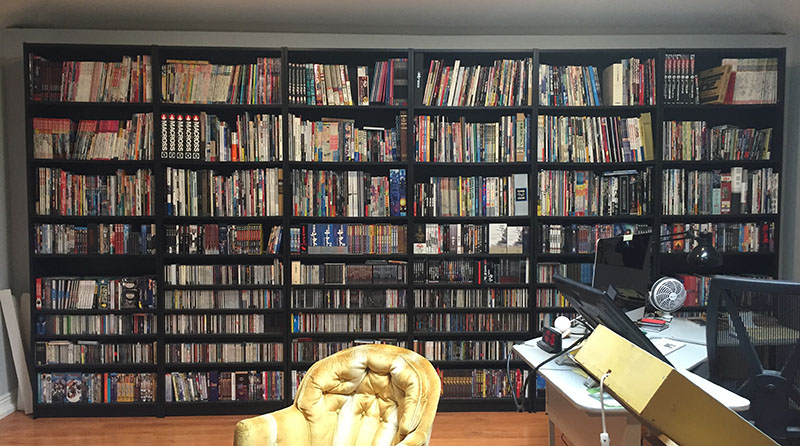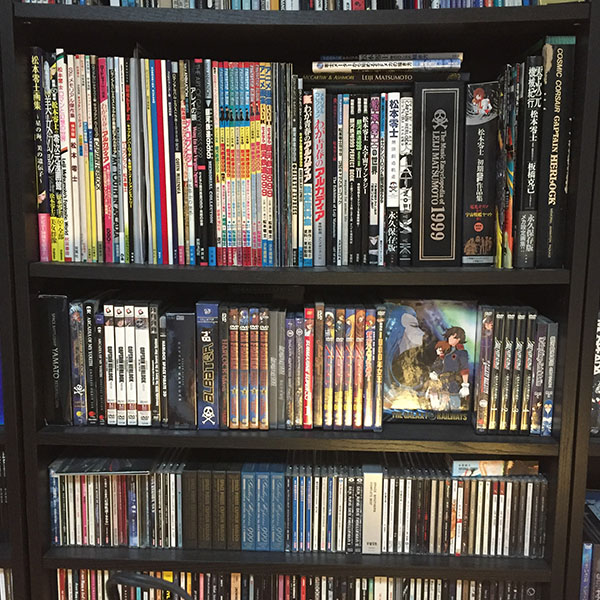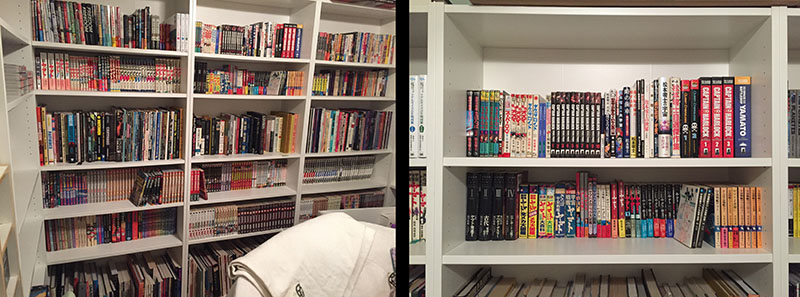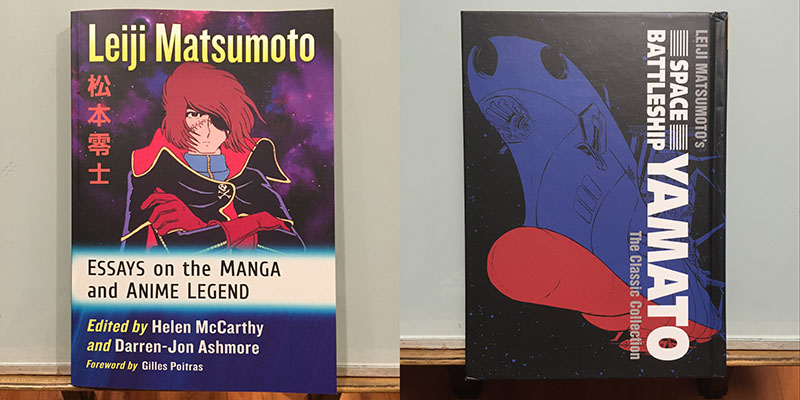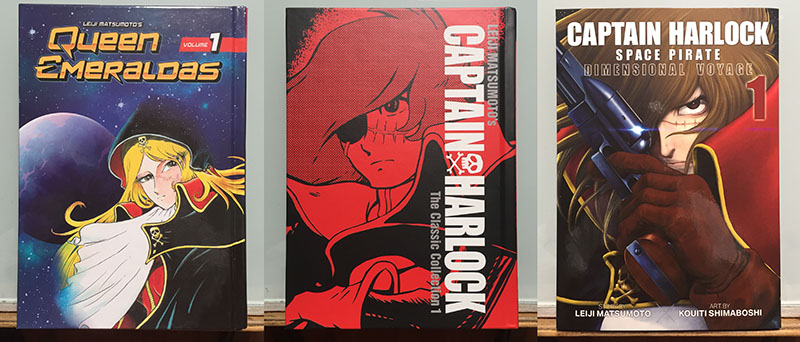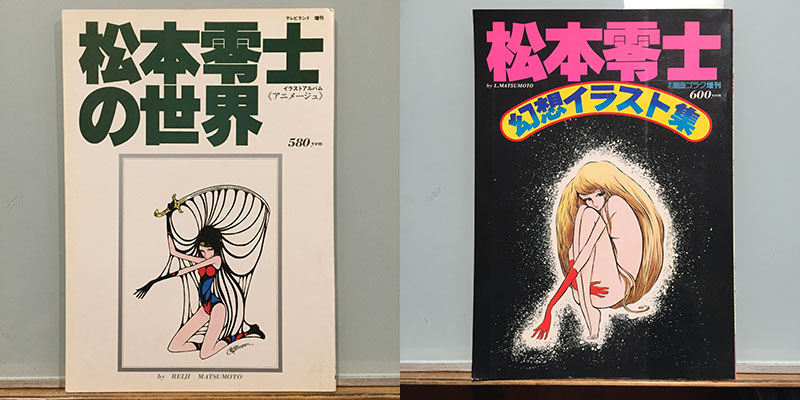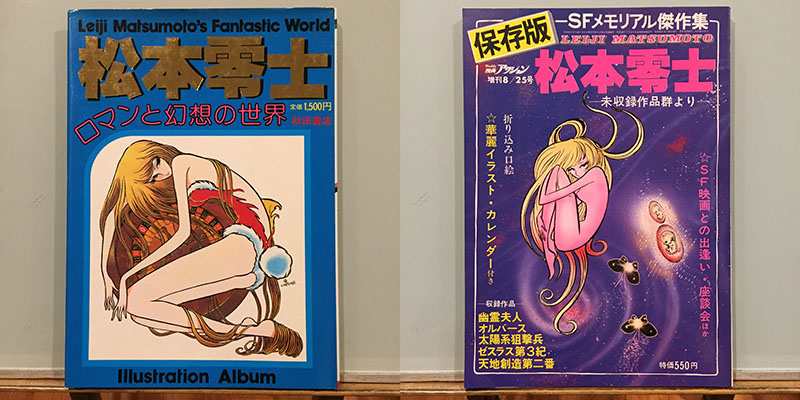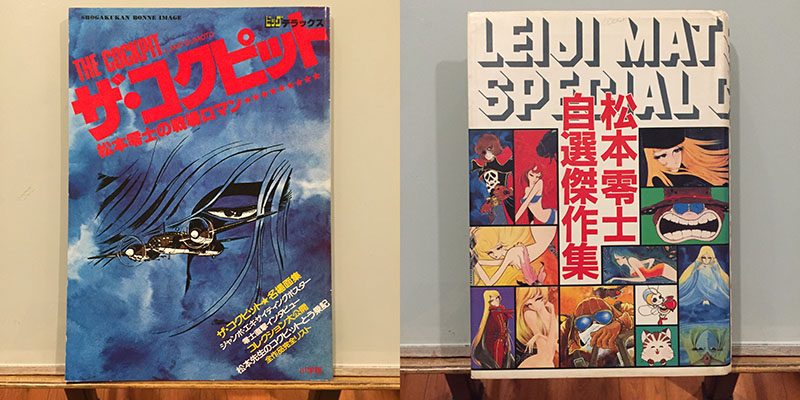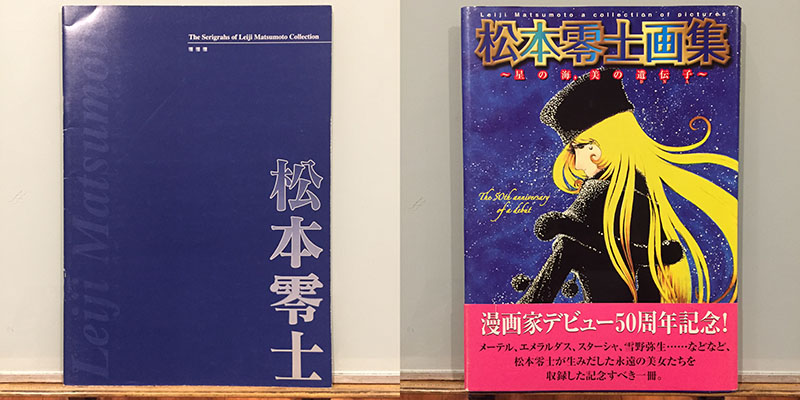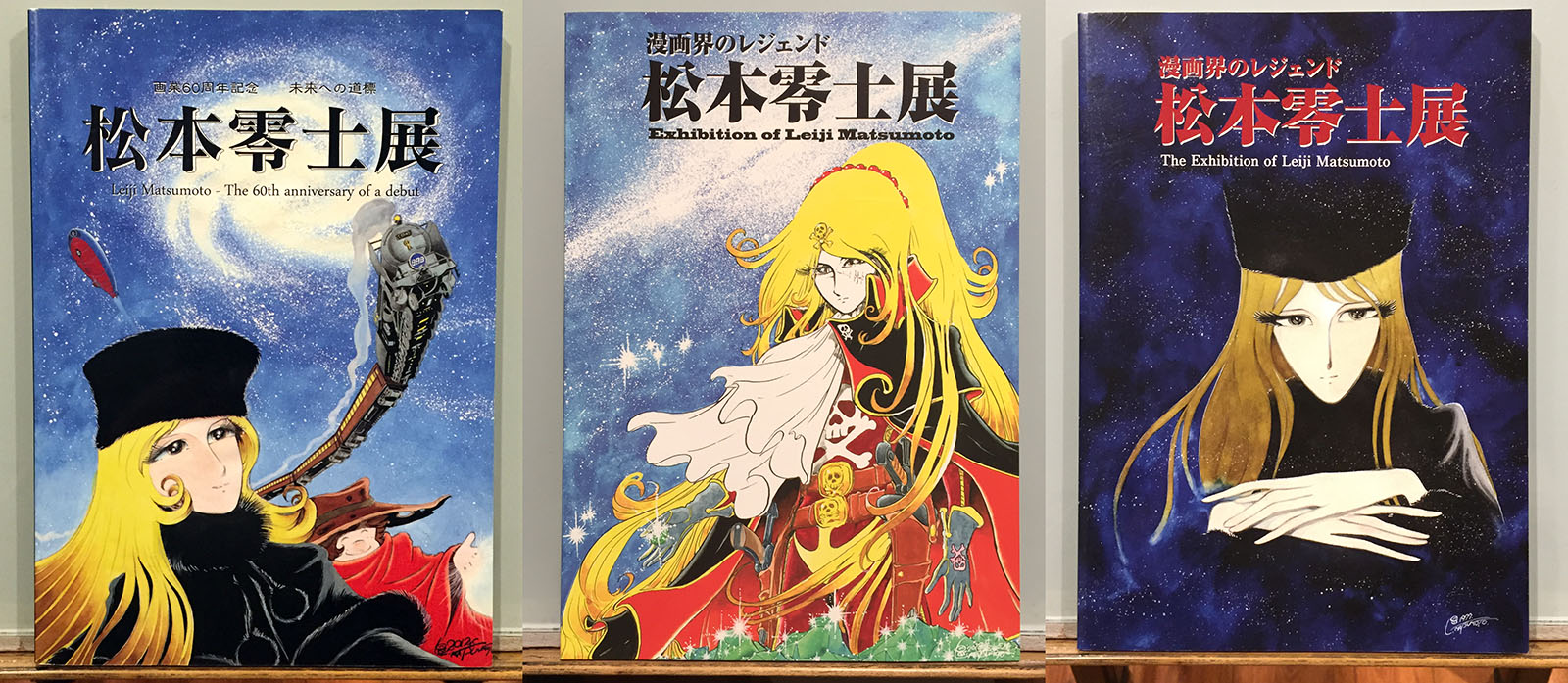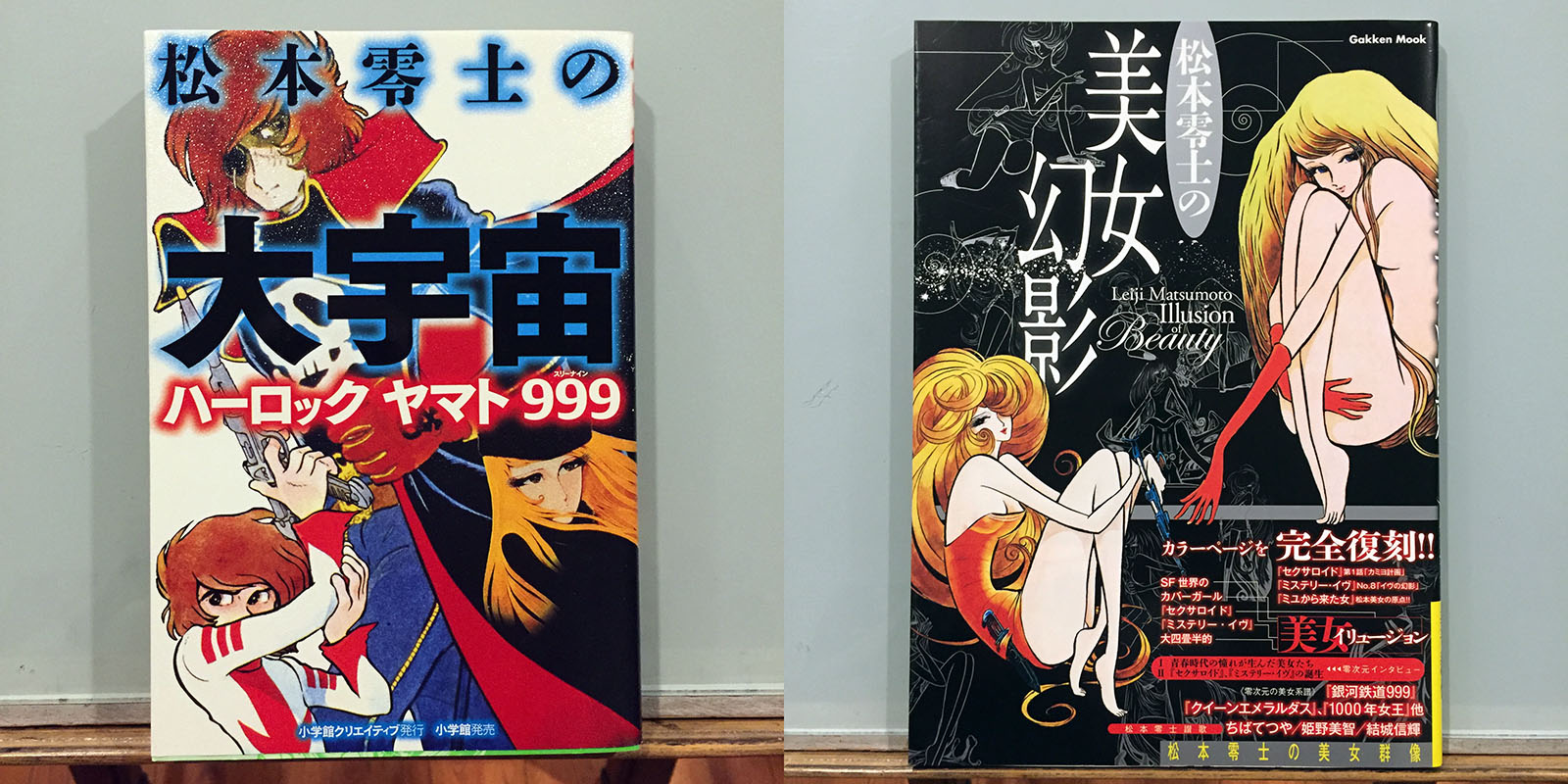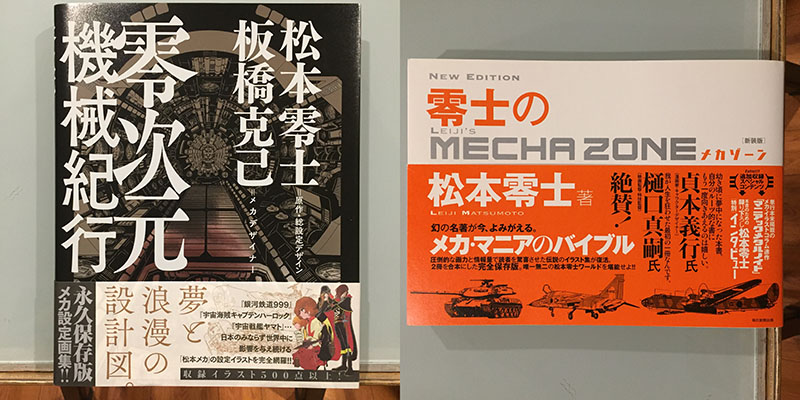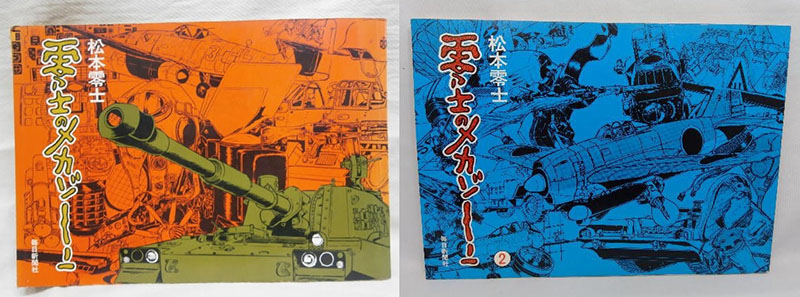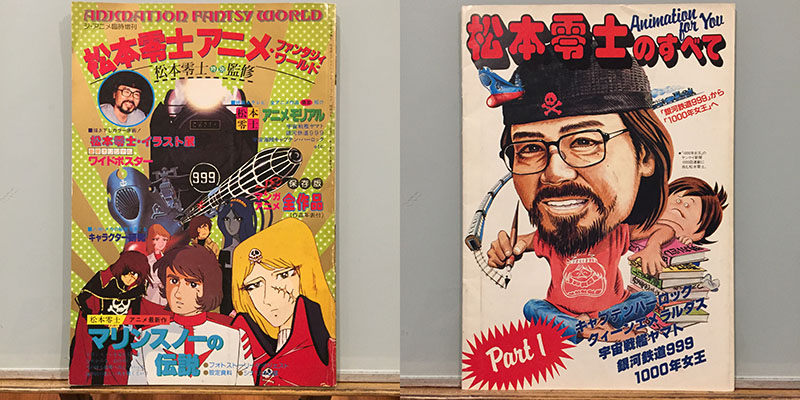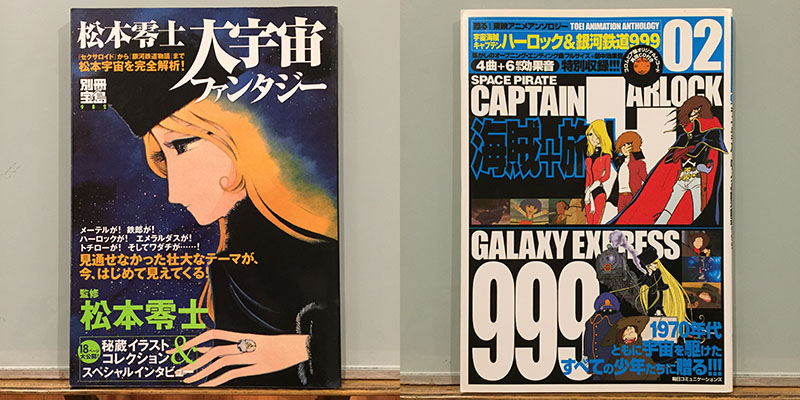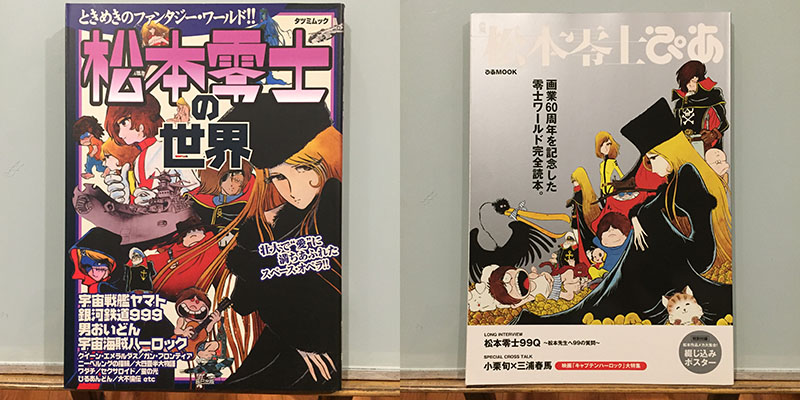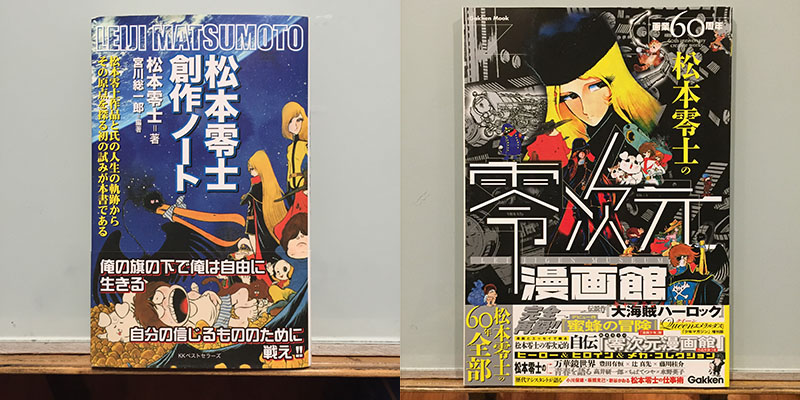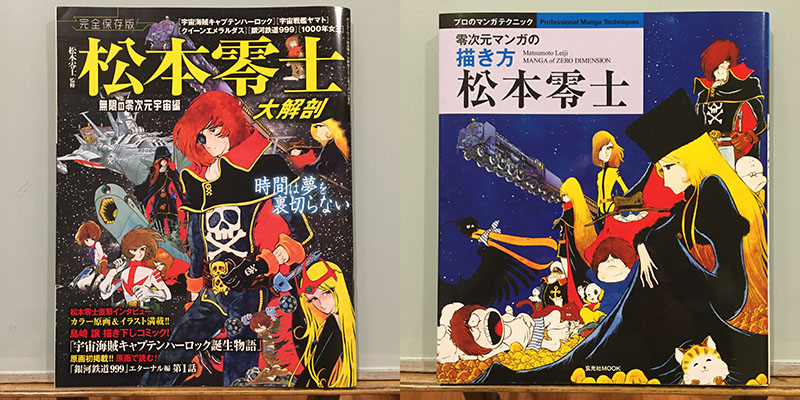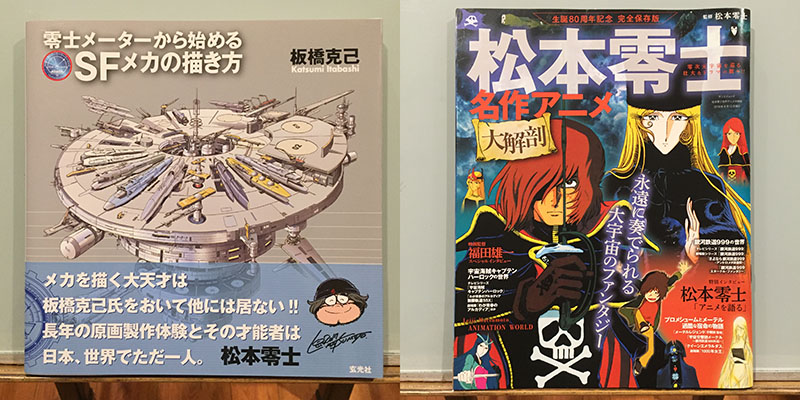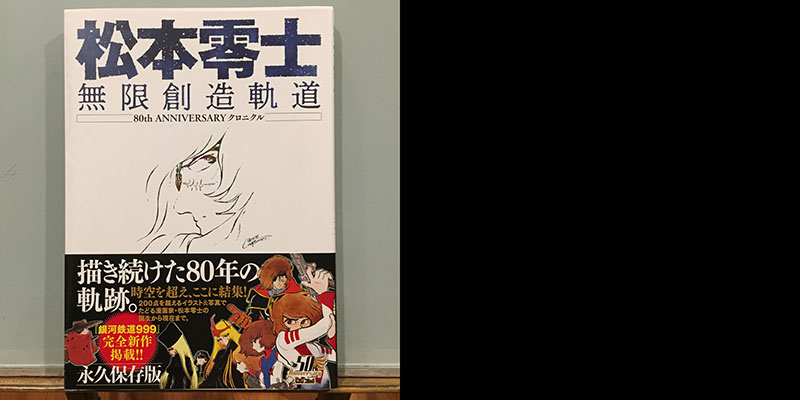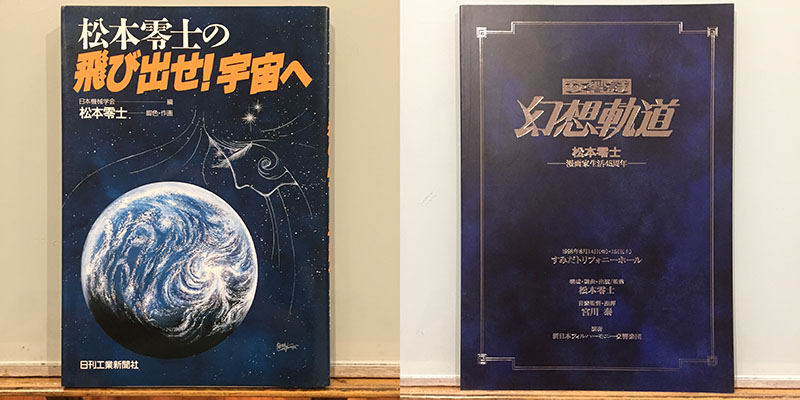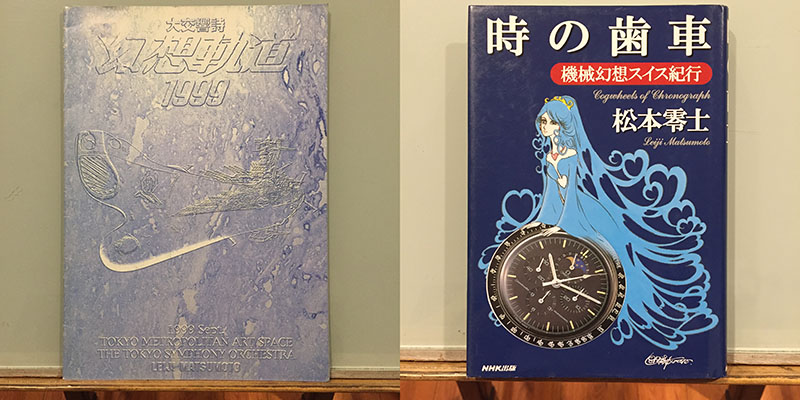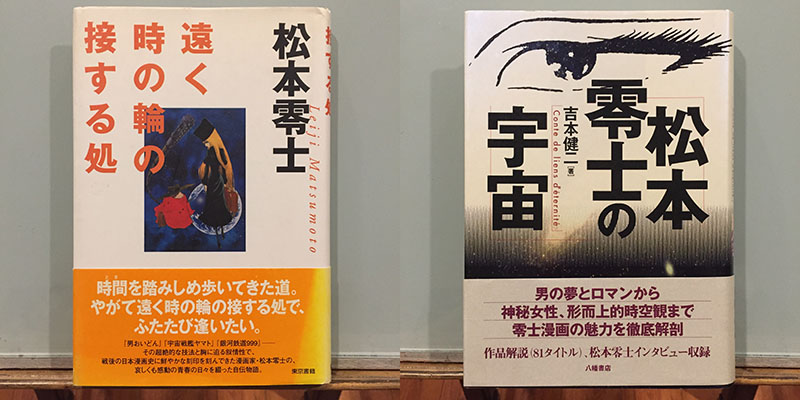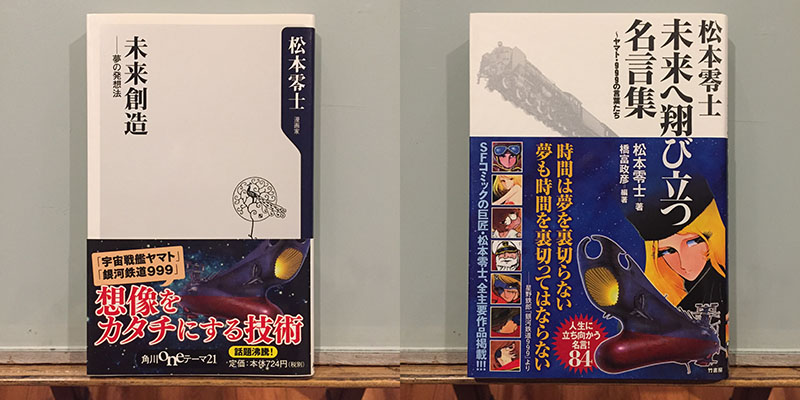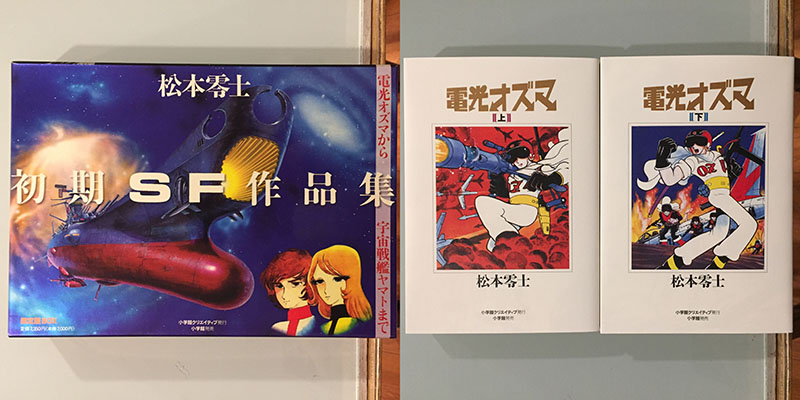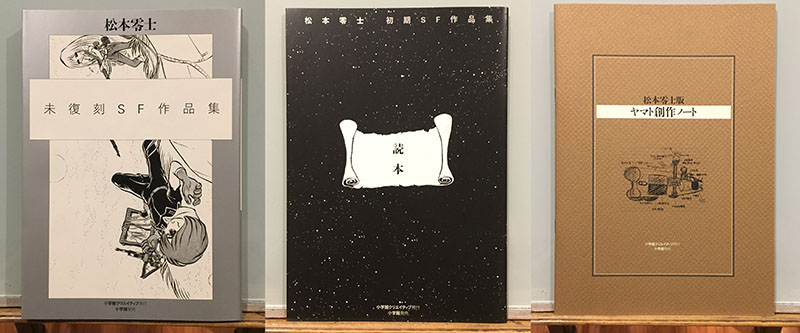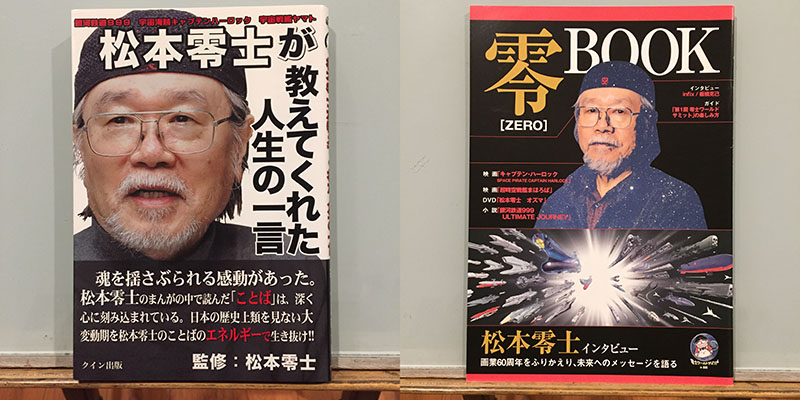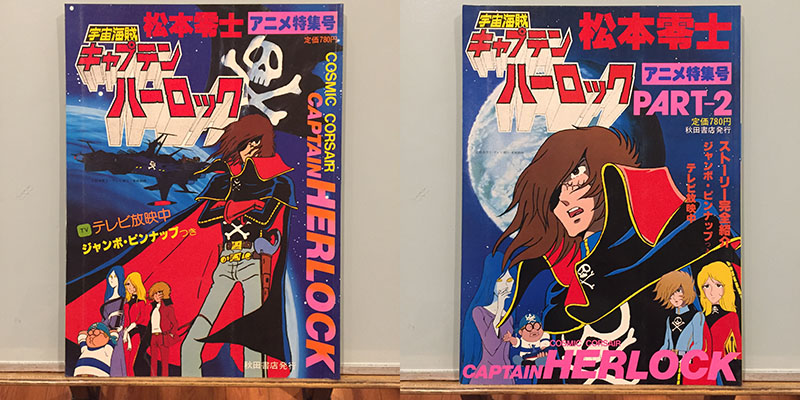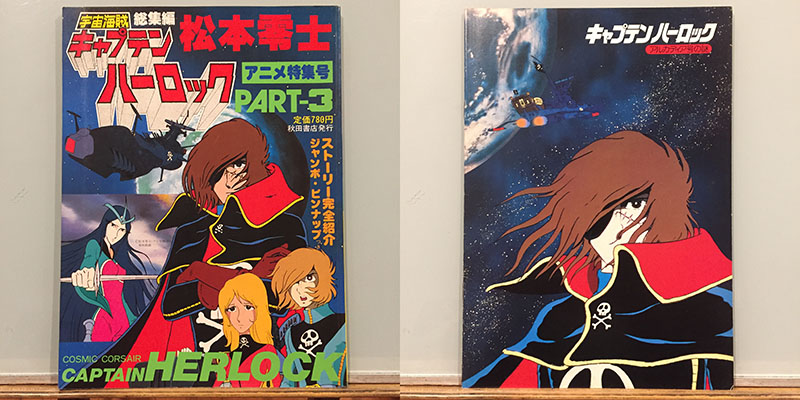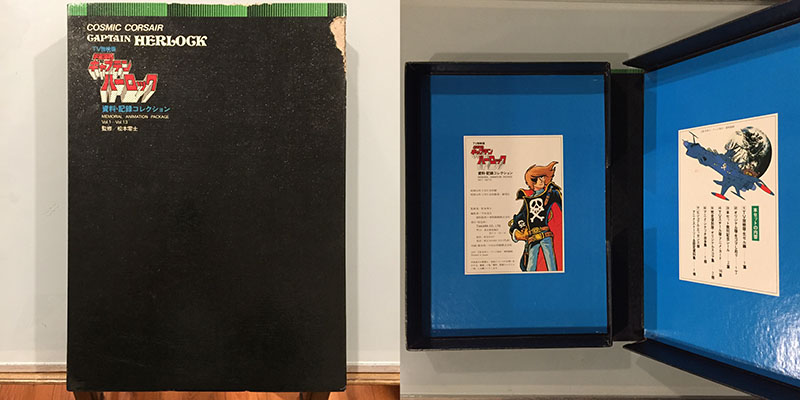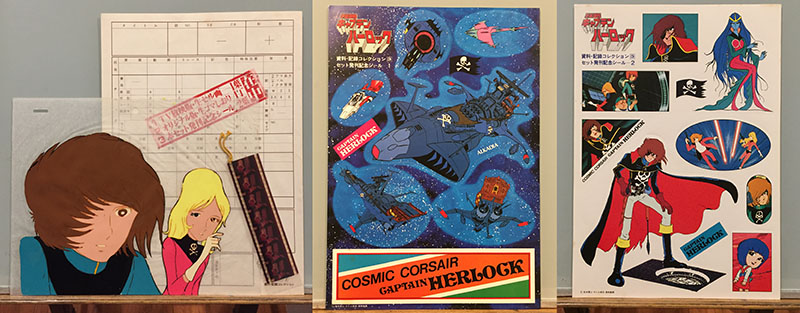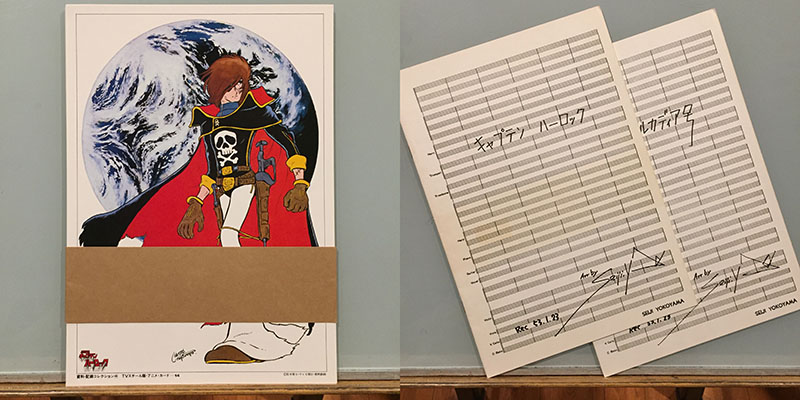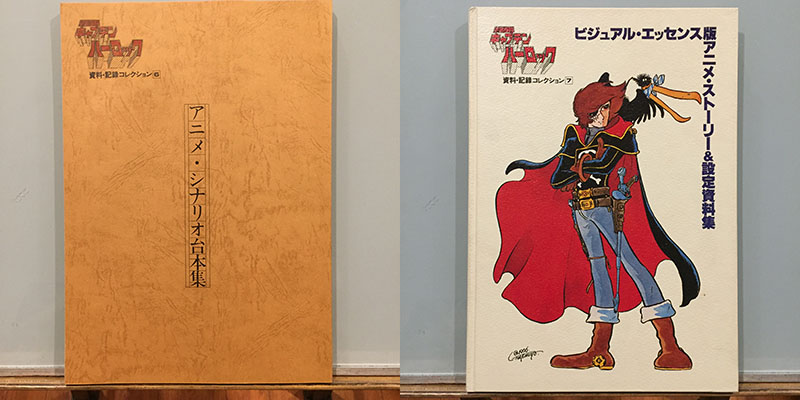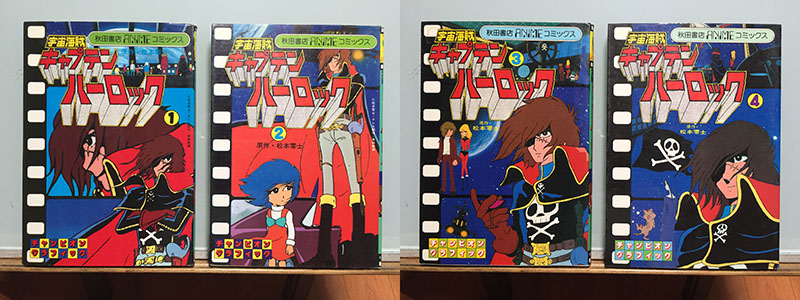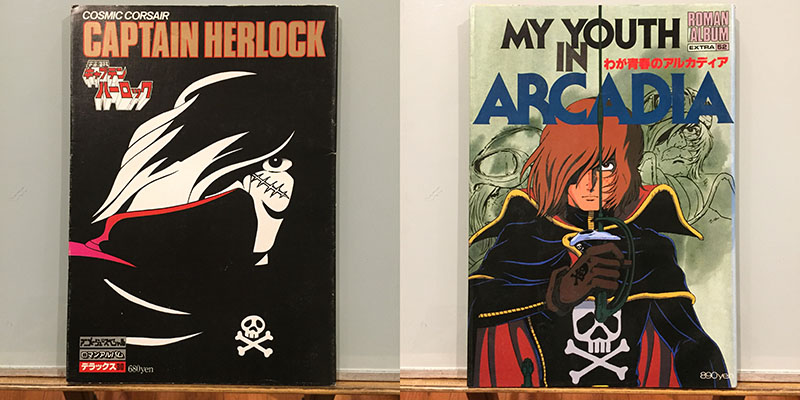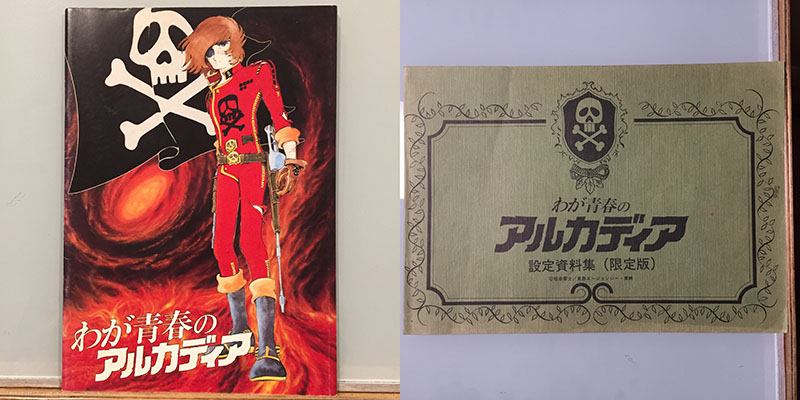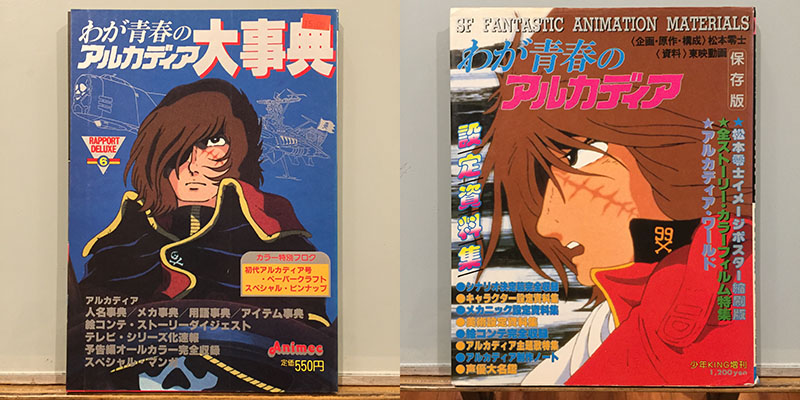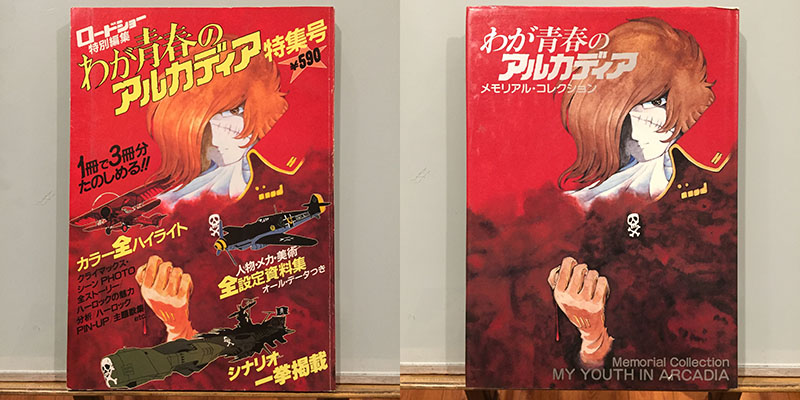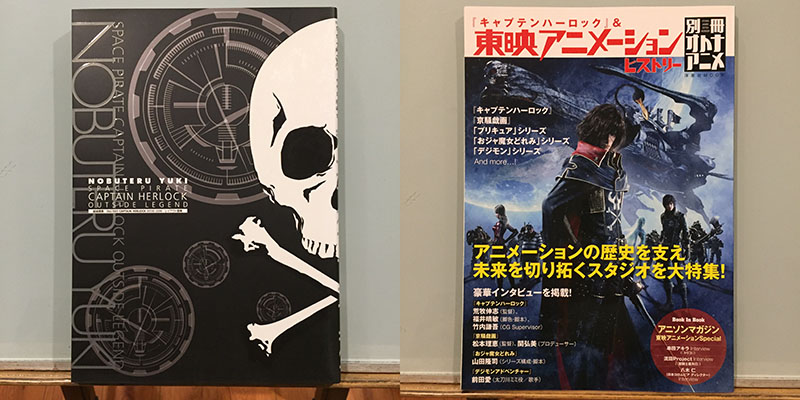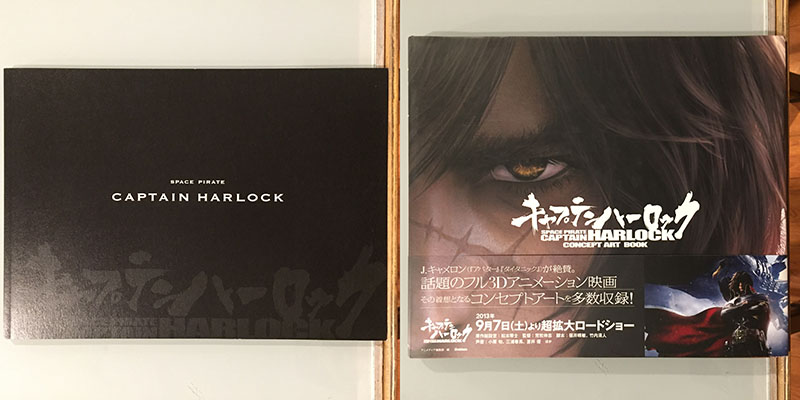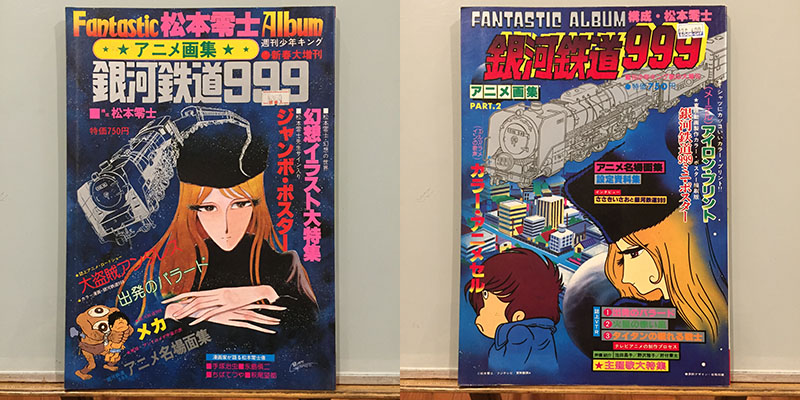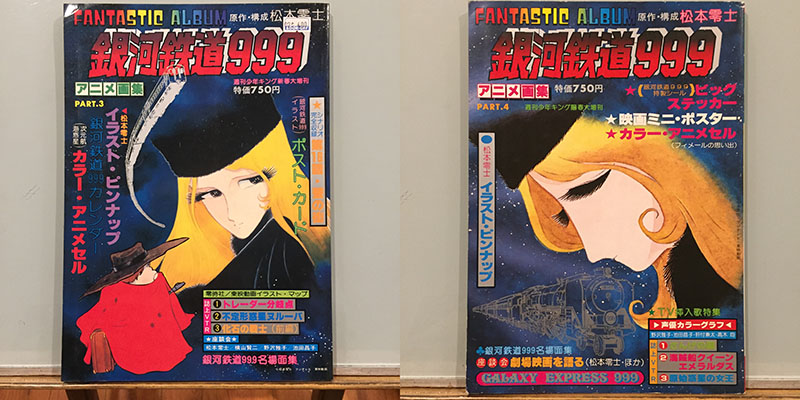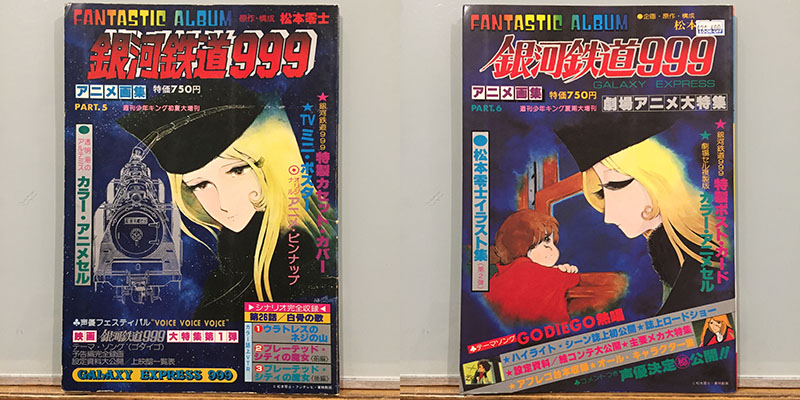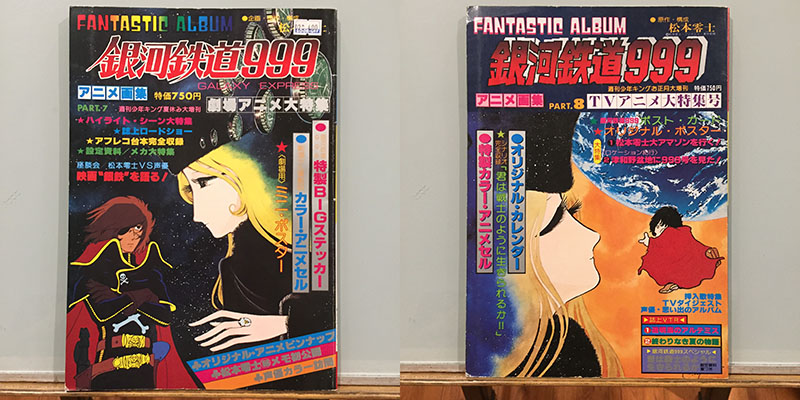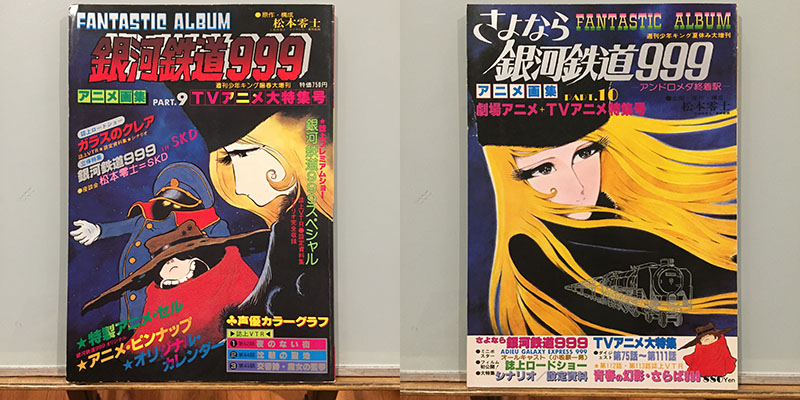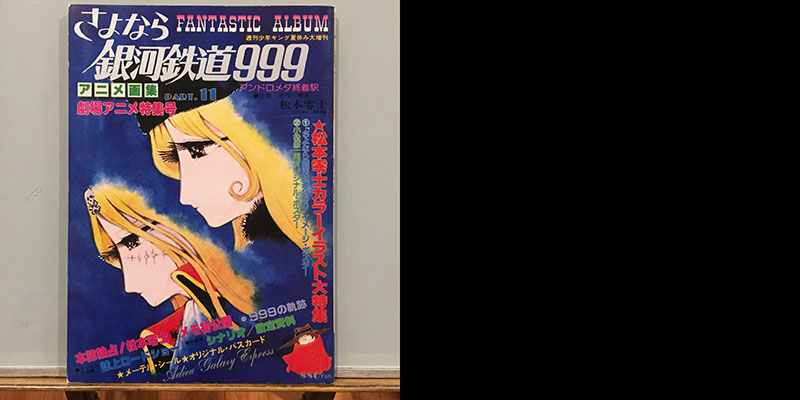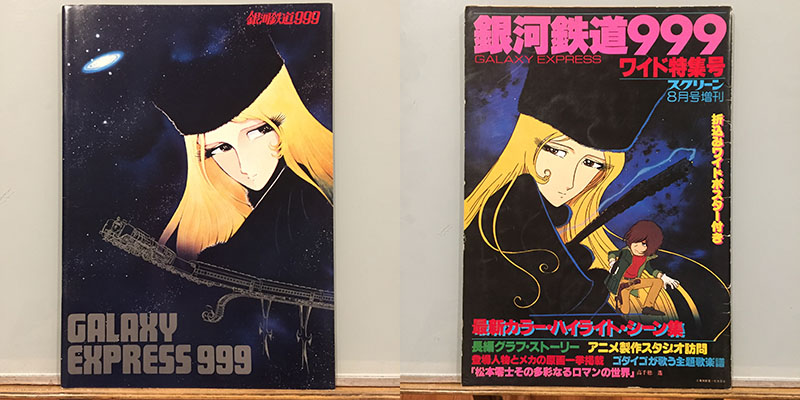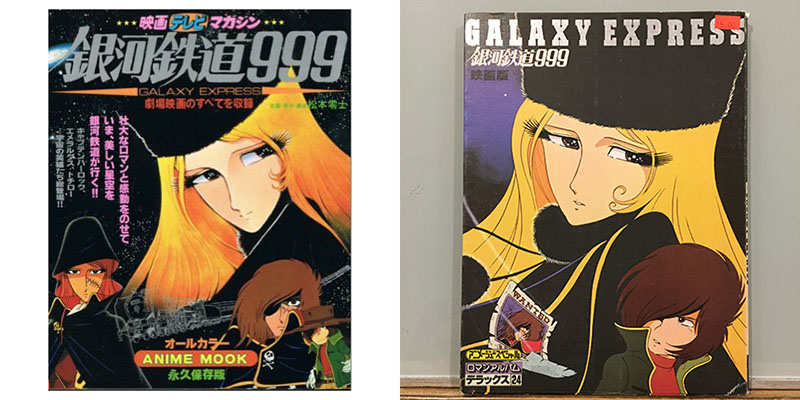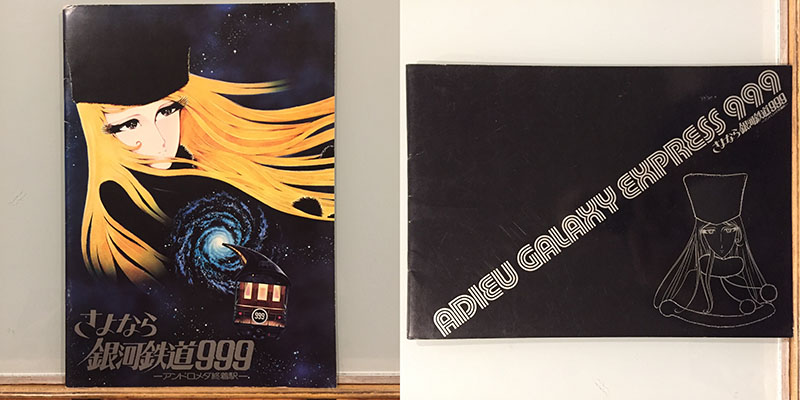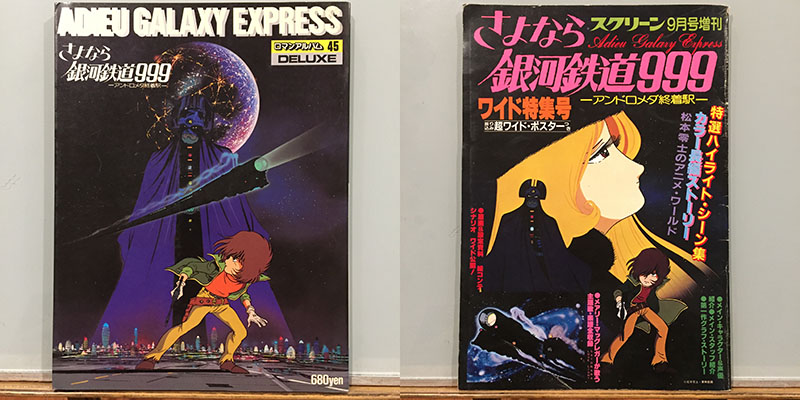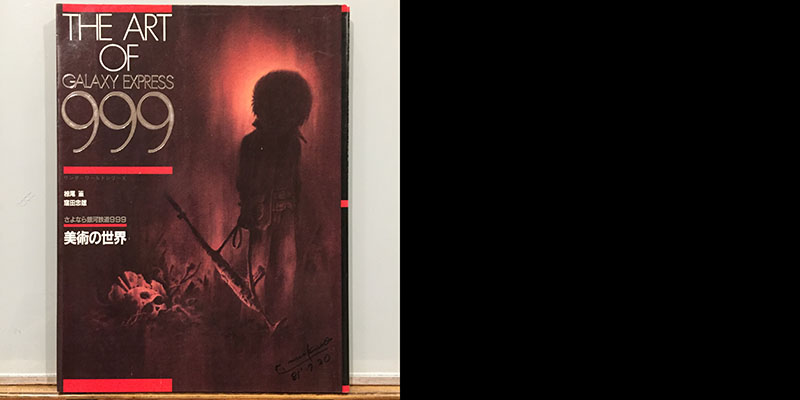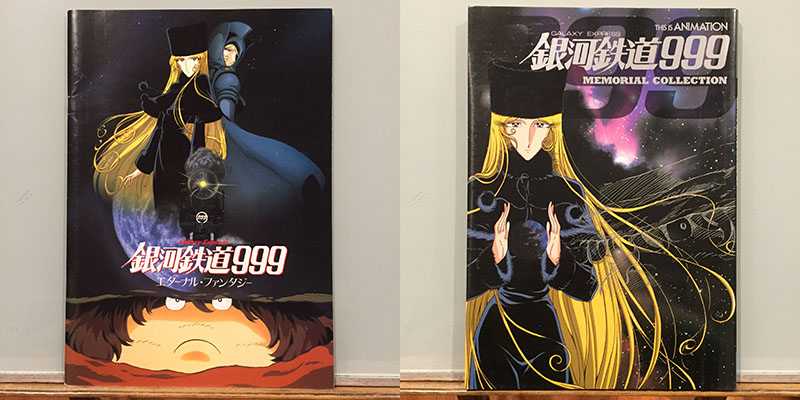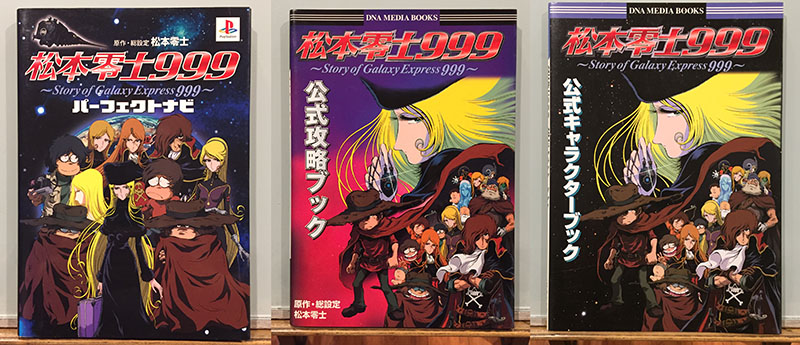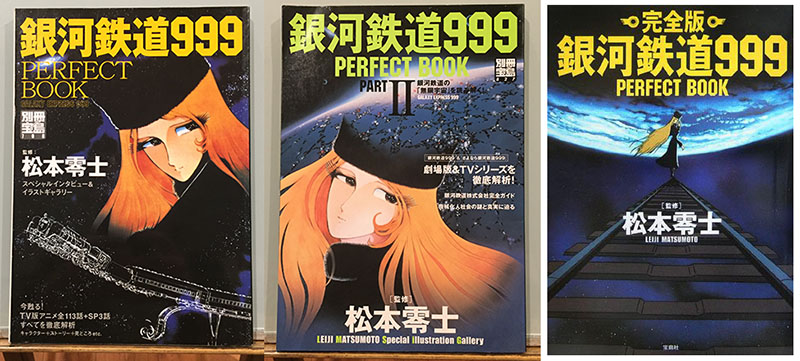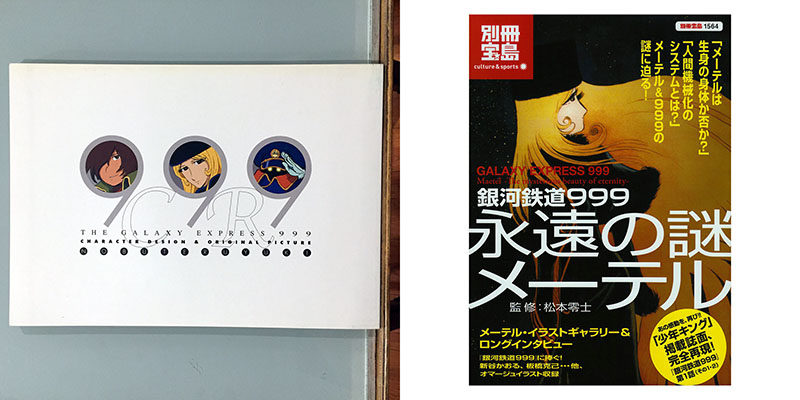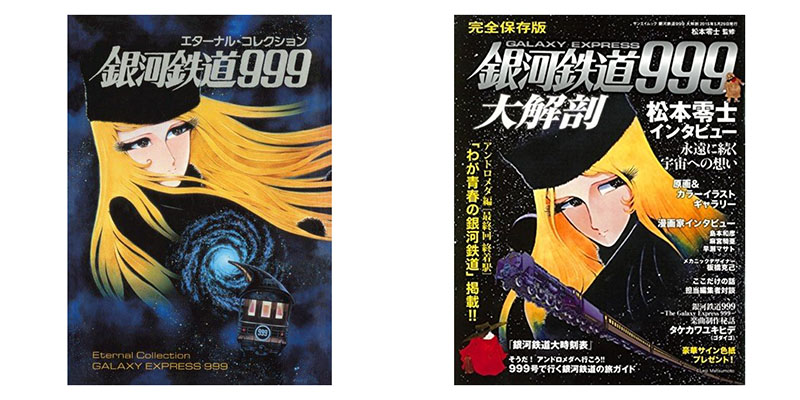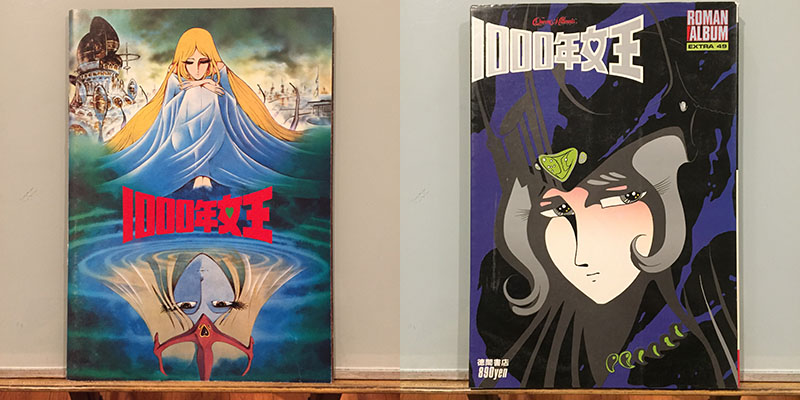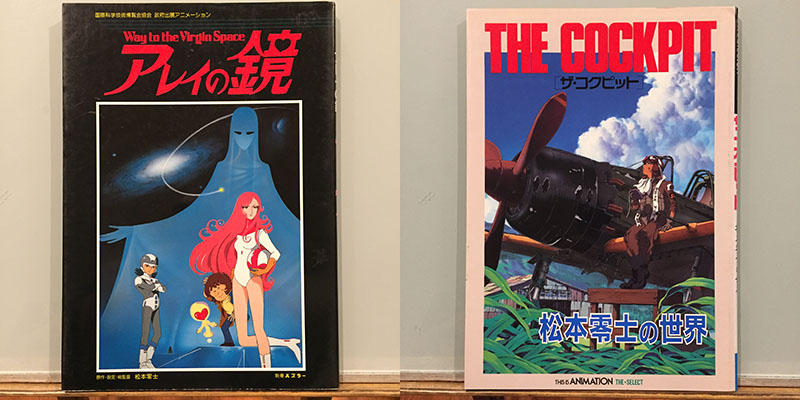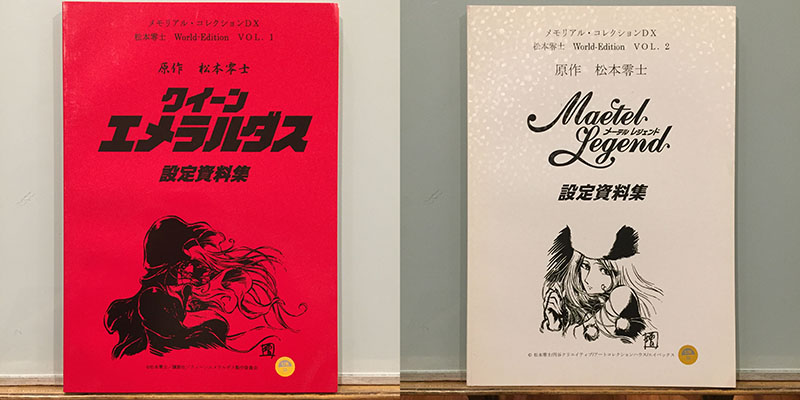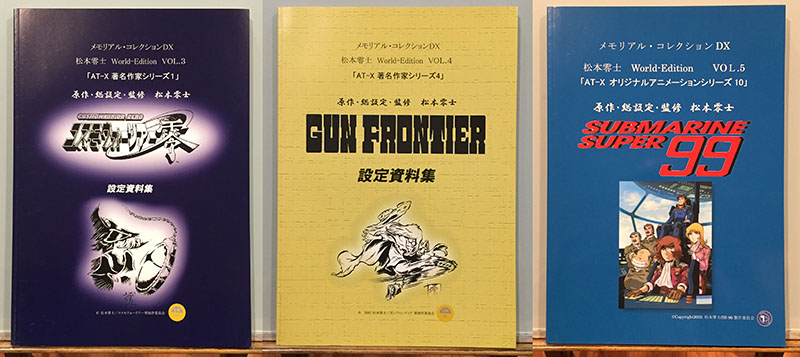Book collection: Leiji Matsumoto
Like most people I know, I love staring at bookshelves to see what treasures wait to be discovered. This is one reason I’ve always surrounded my workstation with bookshelves.
The section I’m focusing on here is devoted to the works of Mr. Leiji Matsumoto, the first Japanese artist I learned about by name. Like many anime fans my age, his work reached me via Star Blazers (the English version of Space Battleship Yamato) and the others followed.
If you haven’t heard of Matsumoto or need a refresher, think of him as the Jack Kirby of Japanese manga. He is known for a huge range of genres from everyday drama to westerns to romance to comedy to elevated science-fiction. Many of his stories cross over in a loosely-organized tapestry he refers to to as the “Ring of Time.”
He began his manga career as a teenager in 1954 and is still going in his 80s. In that time, he inspired an entire generation of imaginative young artists to pursue careers in anime and manga, some of whom grew up to work with him. Thus it should come as no surprise that entire books have been written about the man himself, including one that I contributed to. Read more about him on his Wikipedia page here.
This collection encompasses books on Matsumoto’s anime and manga projects, art collections, retrospectives, biography, and other odds and ends. It is by no means the complete catalog, but it’s definitely extensive. The lower shelves contain video and music, which will get their own article somewhere down the road. You won’t find many Yamato books on this page because I’ve already covered every single one of them over at ourstarblazers.com here. You’ll also find lots of translated Matsumoto interviews here, including one I conducted in person.
Then there are my other shelves, in a room filled with smaller-format paperbacks. More Matsumoto books are kept there. BTW, I’m mostly leaving out manga volumes because there are just so damn many of them in so many differently-packaged editions that sorting through them all would require a whole separate website. All I can do is wish you luck.
Speaking of luck, most of the books shown here are out of print, but the Japanese titles are provided for online search purposes. I’ve given an Amazon.co.jp link for current books. Note that the “Leiji” part of his name is a pseudonym (his real name is Akira), which can translate into the number Zero. Thus, the word Zero shows up in some nomenclature. It’s certainly not a measure of value. Another descriptor that shows up is “roman,” which is a Japanese interpretation of “romance” that is synonymous with “adventure.”
And now, off to the sea of stars!
English Language
Leiji Matsumoto, Essays on the
Anime and Manga Legend
238 pages, text with illustrations
McFarland, 2021
Right off the top, this is the one to start with if you want an introduction. It contains in-depth essays on every dimension of his work. I contributed one that explores his manga techniques and the individuals who interpreted his work for anime.
Space Battleship Yamato
The Classic Collection
648 pages, b&w manga
Seven Seas, 2019
Very little of Matsumoto’s manga has been translated for English-speaking readers, but we have gotten the flagship titles. This massive hardcover collects all of his Yamato manga in one place for the first time anywhere.
Queen Emeraldas
2 volumes, b&w manga
Kodansha Comics, 2016
Captain Harlock
The Classic Collection
3 volumes, b&w manga
Seven Seas, 2018
Captain Harlock, Dimensional Voyage
10 volumes, b&w manga
Seven Seas, 2017-2019
As with Yamato, all three of these titles were translated by the mighty Zack Davisson, another fan who grew up on Star Blazers. The first two are in hardcover, the third is a series of paperbacks. Dimensional Voyage stands out as a modern story by another artist with Matsumoto supervising (part of a continuing trend in Japan, since the guy isn’t getting any younger).
Find them all at Rightstuf and Amazon
Galaxy Express 999
5 volumes, b&w manga
Viz Media, 1999-2002
Galaxy Express is Matsumoto’s most famous creation in Japan, a series that has been running off and on since 1977 in both anime and manga. Viz published these five volumes, all of which are now out of print, so good luck.
Art Collections
The World of Leiji Matsumoto
松本零士の世界
64 pages, color and b&w
Tokuma Shoten, 1977
The first-ever Matsumoto art collection was published by the makers of Animage magazine, six months before the debut Animage itself, which could make this the first publication to carry the name. It contains a unique selection of manga paintings and illustrations, many of which are presented larger than ever before. Captain Harlock and Galaxy Express 999 had recently debuted as manga, so previous titles got much more attention here than they would in coming years.
Leiji Matsumoto
Fantasy Illustration Collection
松本零士幻想イラスト集
80 pages, color and b&w
Nihon Bungeisha, 1978
Like the first collection, this one contains no content that Matsumoto would later become best-known for. Instead, it focuses entirely on his mature titles, such as Sexaroid with numerous color pieces and a complete manga titled Ape Man No. 1470. As his mainstream titles took over, many of the lesser-known pieces found in his first two books were phased out and seldom reprinted.
Leiji Matsumoto
The World of Romance and Fantasy
松本零士ロマンと幻想の世界
123 pages, color
Akita Shoten, 1978
Hardcover collection of color art from major manga and anime titles, many paintings for manga covers and other projects, many of which do not appear elsewhere. Also includes a travelogue of Matsumoto’s trip to Africa.
Leiji Matsumoto
SF Memorial Masterpiece Collection
Preservation Edition
SFメモリアル傑作集 保存版 松本零士
120 pages, color
Futabasha, 1978
Published by Weekly Manga Action magazine, a substantial collection of SF manga created before Captain Harlock and Galaxy Express in large format with an overview of Matsumoto’s earlier works.
The Cockpit, Leiji Matsumoto’s Battlefield Romance
ザ・コクピット 松本零士の戦場ロマン
80 pages, color and b&w
Shogakukan, 1978
Large-format reproductions of paintings, full-page illustrations, and significant pages from Matsumoto’s Battlefield manga series.
Leiji Matsumoto Selected Masterpieces
松本零士 自選傑作集
282 pages, b&w with some color
Sonorama, 1982
A hardcover compendium of favorite chapters from best-known manga titles including Sexaroid, Yamato, Galaxy Express, Battlefield, Gun Frontier, Otoko Oidon, and more. Highly recommended for its outstanding print quality.
The Serigraphs of Leiji Matsumoto Collection
12 pages, color
Art Collection House, 2001
This interesting artifact was never available for sale, which tells me it probably accompanied one of the many annual “World of Matsumoto” art exhibitions that travel across Japan. It’s pretty thin with just a single image per page, but the reproduction quality is exquisite.
Leiji Matsumoto Art Collection
Sea of Stars, Gene of Beauty
松本零士画集 ― 星の海、美の遺伝子
99 pages, color
Aiyusha, 2004
Hardcover, published to commemorate Matsumoto’s 50th anniversary as an artist. Contains many well-known paintings from his biggest anime titles and a large number of manga-related color works from later decades.
Art exhibition catalogs
Annual art exhibitions have been going on for years, touring Japan under such names as The World of Leiji Matsumoto. Original manga art, paintings, cels, and family photos go from location to location, occasionally evolving as new pieces are added. Exhibition catalogs are always there to be purchased, such as these three editions. Their content overlaps to about 95%, but there are a few odd pages in each one. From left to right, they are as follows:
A signpost to the future
Leiji Matsumoto Exhibition
画業60周年記念
未来への道標 松本零士展
Art Space, 2012
Leiji Matsumoto Exhibition
松本零士展
漫画界のレジェンド
Art Space, 2014
Leiji Matsumoto Exhibition
松本零士展
漫画界のレジェンド
Art Space, 2014-2017
The Universe of Leiji Matsumoto
Harlock Yamato 999
松本零士の大宇宙 ハーロック ヤマト 999
312 pages, b&w with some color
Shogakukan, 2013
Published as a tie-in to the 2013 Captain Harlock movie, this thick compendium is a sampler of Matsumoto’s most famous manga titles with chapters from Harlock, Gun Frontier, Harlock, Galaxy Express, Yamato, Sexaroid, Otoko Oidon, The Battlefield, and more.
Order it from Amazon.co.jp here.
Leiji Matsumoto’s Vision of Beauty
松本零士の美女幻影
145 pages, color and b&w
Gakken Plus, 2014
A dense collection of illustrations focusing on female characters, from paintings and drawings for book covers and men’s magazines to manga selections from Sexaroid, Mystery Eve, and others.
Leiji Matsumoto and Katsumi Itabashi: Zero Dimensional Machine Travelogue
零次元機械紀行
272 pages, color and b&w
Shogakukan, 2015
I cannot say enough about this SPECTACULAR hardcover by Katsumi Itabashi, so I’ll let the official promo text do the talking:
“The definitive collection of Matsumoto’s mecha designs that have given birth to so many romances! The mecha designs of Leiji Matsumoto and mecha designer Katsumi Itabashi have had an impact not only in Japan but also around the world. At last, an overwhelming art book that covers most of the setting pictures is born!
The many works of Leiji Matsumoto, one of the great stars of the manga world, have greatly influenced the imaginations of Japanese people. Among them, many may have been excited by the “Matsumoto Meter” and other Matsumoto mecha, which were designed by Matsumoto and realized by mecha designer Katsumi Itabashi.
Many of the mecha settings created by the golden duo over the past 40 years have now been revived in the form of color illustrations and detailed drawings! Mr. Itabashi himself rewrites and colors from the design drawings! More than 400 illustrations in total, including many never-before-seen illustrations! This is the perfect preservation edition of Japan’s world-class mechanic world, drawn with graceful and precise brushwork.”
Take my advice and order this book from Amazon.co.jp RIGHT NOW.
New Edition, Matsumoto’s Mechazone
新装版 零士のメカゾーン
232 pages, b&w with some color
Mainichi Shimbun Publishing, 2018
This one’s pretty damn great, too. Matsumoto wrote and drew a two-volume set of “real world” mecha called Leiji’s Mechazone that was out of print for years until it came back in this single exquisite package. Here’s what the editor had to say about it:
“The bible of mecha mania comes back to life.
I’m glad to be able to revisit this book, which I fell in love with when I was a child. I’m glad to be able to revisit my roots in this book. It’s the first book that made my life crazy.
Published in 1978 and 1979 (original editions shown below), this fantastic masterpiece, which astounded readers with its overwhelming power of drawing and amount of information, has been revived in a new combined edition of the two books!
This book is a collection of illustration columns that thoroughly guides readers through the world’s mecha, including fighter planes, tanks, guns, and more, using authentic illustrations and text based on actual experience. This book is filled with the author’s love for mecha, who says, “MechaZone is the work that made my boyhood dreams come true.”
At the end of the book, there are special contents: Maniac Metaloid, an illustrated work (serialized in Armor Modeling magazine from 2010 to 2011) reprinted for the first time. This is a completely preserved edition where you can enjoy the unique world of Leiji Matsumoto.”
Order it from Amazon.co.jp here.
Retrospectives
Leiji Matsumoto Anime Fantasy World
The Anime Extra Edition
松本零士 アニメ・ファンタジーワールド ジ・アニメ臨時増刊
high page count, color
Kindaieigasha, 1980
This was the first book to focus entirely on Matsumoto’s anime works with its main focus on the newly-released Legend of Marine Snow. Includes a rare glimpse of his earlier anime series Danguard Ace and Starzingers in addition to the other anime works and a chronological manga index up to the time of publishing. Published as an extra edition of The Anime magazine.
All About Leiji Matsumoto, Part 1
松本零士のすべて
20 pages, color
Unknown publisher, 1980
This one is a real oddball with no apparent sponsorship. It’s a short primer for those who may be unfamiliar with Matsumoto’s anime works, with an emphasis on Queen Millennia, which had recently debuted as a manga and would reach TV the next year. It says Part 1 on the cover, but I have yet to find a Part 2.
Leiji Matsumoto, Great Space Fantasy
松本零士 大宇宙ファンタジー
159 pages, color and b&w
Takarajima Co., 2004
An thorough encyclopedic examination of Matsumoto’s space-themed stories, leading with Galaxy Express and Captain Harlock, then diving deeper into all his other works with a specific leaning toward outer space themes. Stands out for its extensive roundup of both manga and anime titles that get less attention elsewhere.
Captain Harlock & Galaxy Express 999 (Revive! Toei Anime Anthology Vol. 2)
キャプテンハーロック & 銀河鉄道999 (甦る! 東映アニメアンソロジー)
71 pages, color
Mainichi Communications, 2004
This was the second of three books that specialized in retrospectives on popular Toei TV series. This one was split between Space Pirate Captain Harlock and Galaxy Express with a bonus CD containing their original theme songs.
The World of Leiji Matsumoto
松本零士の世界
240 pages, color and b&w
Tatsumi Publishing, 2005
An excellent compendium of Matsumoto’s major manga titles, and a few minor ones, with examinations of characters and concepts. Includes another publishing index up to the time of this book.
Leiji Matsumoto Pia
松本零士ぴあ
97 pages, color
Pia Publishing, 2013
Published to tie in with the 2013 Harlock movie, presents a broad overview of the character in anime and Leiji Matsumoto’s entire career in both anime and manga. Includes a collection of art from the unproduced Mahoroba anime project, possibly found nowhere else.
Leiji Matsumoto Creation Note
松本零士創作ノート
215 pages, xxx
Bestsellers, 2013
This paperback is essentially a collection of Matsumoto manga with liner notes. Each chapter is devoted to a single manga title with a selection of finished pages followed by a text explanation. Think of it as a print version of a movie commentary with selected scenes from different movies.
60th Anniversary, Leiji Matsumoto’s
Zero Dimension Manga Museum
画業60周年 松本零士の零次元漫画館
133 pages, color and b&w
Gakken Plus, 2014
“A book commemorating the 60th anniversary of Leiji Matsumoto, includes a complete reprint of the legendary Great Pirate Harlock, which is said to be the prototype for Space Pirate Captain Harlock, his debut work The Adventure of a Honeybee, and other valuable works. The book is filled with a wealth of materials, interviews, and character collections!”
Leiji Matsumoto, Great Dissection
松本零士 大解剖
126 pages, color
Sanei Shobo, 2016
A splashy, densely-packed overview of Matsumoto’s major manga works, peppered with original art, analysis articles, interviews, product catalogs, and much more.
Leiji Matsumoto: How to Draw
Zero-Dimensional Manga
松本零士 零次元マンガの描き方
142 pages, color and b&w
Genkosha, 2017
This interesting book is equal parts art collection and manga study. All the major (and some minor) works are examined with many classic paintings and illustrations. The real meat of the presentation comes in two sections: the first manga chapter of Sexaroid with page-by-page composition notes, and a reproduction of Leiji Matsumoto’s Manga Technology, a series of how-manga-is-made magazine articles that had never been reprinted until now.
Order it at Amazon.co.jp here
How to Draw SF Mecha,
Starting With the Leiji Meter
零士メーターから始めるSFメカの描き方
167 pages, color
Genkosha, 2017
This would have come in REALLY HANDY back when I was drawing Captain Harlock comics for Eternity, but better late than never.
“In this book, Katsumi Itabashi explains how he studied under Leiji Matsumoto and developed his skills over half a century to become a mecha creator that even his master respected. The vast amount of drawings included in the book are all Itabashi’s originals. From the meter to the cockpit, and even the structural drawings of the spaceship, the book can be enjoyed as a collection of exquisite mechanical illustrations. This is a never-before-seen volume on how to improve your skills in depicting mechanics.”
Order it from Amazon.co.jp here
Leiji Matsumoto Masterpiece Anime Great Dissection
松本零士 名作アニメ大解剖
127 pages, color
Sanei Shobo, 2018
Published as a companion to Sanei Shobo’s 2016 “Great Dissection” magazine, this one devotes the same energetic coverage to Matsumoto’s anime projects up to the time of publication. Since no new Matsumoto anime has appeared since then, it is the most current source.
Order it from Amazon.co.jp here.
Leiji Matsumoto Infinite Creation Orbit: 80th Anniversary Chronicle
松本零士 無限創造軌道: 80th ANNIVERSARY クロニクル
207 pages, color and b&w
Shogakukan, 2018
So many retrospectives appeared in the 2000s one might suspect everyone intended for theirs to be the last one before Matsumoto’s retirement, but the man kept going and outlasted them all. The most recent is probably the most special since it commemorated Matsumoto’s 80th birthday. The publisher’s description reads as follows:
“This is the ultimate collection of his works, compiled with the cooperation of animation companies, record companies, and others. From his debut work to his latest work, Matsumoto’s footprints are thoroughly studied with over 200 illustrations and photos. The book also includes many materials that even long-time fans have never seen before.
In particular, illustrations from his fanzine days and newspaper cartoons from his debut, valuable materials that have never been included in any previous book on Leiji Matsumoto.
This book is not only a collection of gorgeous illustrations showing the 80 years of master artist Leiji Matsumoto who created science fiction comics, but it is also an important source of information about the early days of Japanese manga. This is a book that should be read not only by Matsumoto fans, but also by anyone who loves manga. The most remarkable thing is that it contains the first new Galaxy Express manga in over a decade!”
Order it from Amazon.co.jp here
Miscellaneous
Separate Volume New Review
The World of Leiji Matsumoto
別冊新評 松本零士の世界
226 pages, b&w
New Review Co., 1979
An extensive look at Matsumoto’s manga career from the beginning up to the time of publication with an interview and analysis of key titles. Mostly text with selected illustrations. Includes a mini-encyclopedia and index list of titles.
Frontline People, Leiji Matsumoto
ぴーぷる最前線 松本零士
189 pages, b&w
Fukutake Shoten, 1983
A collection of interviews, career analysis, and biographical pieces, heavily supported by photos and illustrations that captured the life of Matsumoto at 45 years old.
Leiji Matsumoto’s Let’s Go! to Space
松本零士のとびだせ宇宙へ
164 pages, b&w
Nikkan Kogyo Shimbun, 1996
“What is humanity, what is the world, what is space, and what is time? The answers to these questions lie in space. This manga by Leiji Matsumoto examines space development, including the space station, and presents it to you, the people who will carry dreams and hopes into the 21st century.”
Manga and illustrations that vividly capture scientific principles and theoretical possibilities in space travel. Essentially a dramatized space textbook. Can be ordered here, but does not ship outside Japan.
Great Symphony Fantasy Orbit 1998 program book
大交響詩 幻想軌道
28 pages, color, 1998
As his signature year 1999 approached, Matsumoto was riding high on a renewed wave of popularity. His most popular titles were getting rebooted, new anime projects were popping up, and he even looked poised to take over the blockbuster Yamato franchise (though he ultimately lost a court battle over it). His eminence was celebrated in the first of two symphonic concerts that brought together some world-class talent to perform songs and themes from his body of work. It was later released on CD and still stands at the top of its genre. This program book did double-duty as a magazine to examine how music expresses Matsumoto works.
Read an interview from this book here.
Great Symphony Fantasy Orbit 1999 program book
大交響詩 幻想軌道
20 pages, color, 1999
Of COURSE there was going to be another huge concert in 1999, and there was still plenty of music left over after the first one to fill it up. The accompanying program book was a little smaller but no less interesting, with beautiful new artwork that was rarely found all in one place.
The Ring of Time
Mechanical Illusion Swiss Travelogue
時の歯車 ― 機械幻想スイス紀行
206 pages, b&w with some color
Japan Broadcast Publishing Association, 1999
“Leiji Matsumoto, a great admirer of handmade mechanical watches, is drawn to the romance of chronographs and visits Swiss watchmaking workshops. This is the first time he has shown all of his valuable watch materials.”
Hardcover, mostly text with photographs and a few illustrations. We’ve all seen the signature “Leiji meters” in his manga and anime, and this book explains his fascination with their real-world equivalents.
Leiji Matsumoto Music Complete Works
松本零士音楽大全
10 CD set
Columbia, 2000 (limited to 1999 units)
This amazing set really belongs in a music roundup, but it’s big enough to sit on my bookshelf so it gets the attention it deserves. As a devotee of dramatic, classical music, Matsumoto has always put special emphasis on it in his anime projects. The results have always been spectacular, but lesser-known titles had not migrated from LP to CD until this set arrived to put things right. Here, alongside the headliners like Yamato, Harlock, and Galaxy Express, you will find music from Queen Emeraldas, The Legend of Marine Snow, Danguard Ace, Starzinger, SSX, and others. Also includes an 80-page book of articles and liner notes.
Where the Ring of Time Meets in the Distance
遠く時の輪の接する処
190 pages, b&w
Tokyo Shoseki, 2002
“The autobiography of Leiji Matsumoto, a manga artist who has left a vivid imprint on postwar Japanese manga history with his superb techniques and heartbreaking lyricism.”
Hardcover, mostly text with biographical illustrations by Matsumoto. Read the Yamato chapter here.
Leiji Matsumoto’s Universe
松本零士の宇宙 Conte de liens d’eternite
403 pages, b&w
Yawata Shoten, 2003
“A thorough dissection of the appeal of Leiji’s manga, from the dreams and romance of men to mysterious women and metaphysical views of time and space. Includes commentary on 81 titles and an interview with Leiji Matsumoto.”
This impressive hardcover by Kenji Yoshimoto includes an complete historical index up to the time of publication. (Mostly text with illustrations.) Order it from Amazon.co.jp here.
Creating the Future
How to Think of Dreams
未来創造 夢の発想法
199 pages, b&w
Kodokawa Shoten, 2010
This paperback is all text, an examination of how Matsumoto’s life experiences shaped his creative philosophies and his process for developing ideas.
Leiji Matsumoto’s Words of Wisdom for Flying into the Future: Words from Yamato and 999
松本零士未来へ翔び立つ名言集 ヤマト・999の言葉たち
195 pages, b&w
Takeshobo, 2010
Text and manga excerpts are used to introduce and profile characters using significant dialogue from many of Matsumoto’s best-known stories.
Leiji Matsumoto Early SF Works Collection
Limited Edition Box from Lightning Ozma to Space Battleship Yamato
松本零士 初期SF作品集 限定版BOX 電光オズマから宇宙戦艦ヤマトまで
Shogakukan Creative, 2010
Timed for the arrival of the live-action Space Battleship Yamato movie in 2010, this box set rounded up Matsumoto’s earlier manga works that laid the groundwork for Yamato to reassert his contribution to the franchise. It included a two-volume reprint of his Lightning Ozma manga which, among other things, was the first to name a spaceship Yamato. The other elements in the set were…
Seminal SF Works, a 160-page compendium of four manga stretching from 1961 to 1970 that each contained some feature (a concept, a mecha design, etc.) that would later inspire something in Yamato. It also contained a reprint of an illustrated Yamato serial story created for a children’s magazine.
A 16-page interview booklet in which Matsumoto explained how he created and developed concepts in his manga that would contribute to the creation of Yamato, and his participation in the anime.
A 32-page booklet containing his original notes for the Yamato anime series itself during its 1973/74 development. Read a translated version here.
If you’re sensing that Matsumoto was trying to make a point with all this, you’re correct. By this time, he had lost his legal bid to take control of the franchise, and he no longer had a financial claim in its success. It wasn’t the outcome he wanted, but he was certainly within his rights to remind everyone that it wouldn’t have gotten this far without him.
Leiji Matsumoto
Words of Life Taught to Me
松本零士が教えてくれた人生の一言
174 pages, b&w
Quinn Publishing, 2011
Co-written by Soichiro Miyagawa, this is a review and analysis of famous dialogue from Galaxy Express, Captain Harlock, Yamato and other manga. An exploration of the inspiration, meaning, and philosophy behind important moments on Matsumoto stories.
Leiji Book
零 BOOK
24 pages, color
Zero Goods Universe, 2012
Published by Matsumoto’s own company, this was a mini-magazine that promoted upcoming projects and events. It included an early look at images from the 2013 Captain Harlock movie, the as-yet-unproduced Maharoba and works in various other media such as music and DVD. It also included an index of sites across Japan with Matsumoto-related content, such as museums and galleries.
Captain Harlock
Space Pirate Captain Harlock
Anime Special Edition
宇宙海賊キャプテンハーロック アニメ特集号
83 pages, color
Akita Shoten, 1978
This was the first of three volumes, published about a month after the launch of the Space Pirate TV series. Together, these volumes are the still the best print resource for color images from the show. This one introduces characters and mecha in the first 9 episodes.
Space Pirate Captain Harlock
Anime Special Edition Part 2
宇宙海賊キャプテンハーロック アニメ特集号 PART 2
82 pages, color
Akita Shoten, 1978
Published six months after Part 1, this volume restarted and expanded the series coverage, taking us through Episode 18.
Space Pirate Captain Harlock
Anime Special Edition Part 3
宇宙海賊キャプテンハーロック アニメ特集号 PART 3
83 pages, color
Akita Shoten, 1979
The final volume arrived two months after the TV series ended, picking up with Episode 19 and going all the way to the end.
Space Pirate Captain Harlock
The Mystery of the Arcadia
movie program book
宇宙海賊キャプテンハーロック アルカディア号の謎
16 pages, color, 1978
In the 70s, Toei studio would release “anime festivals” as special theatrical events for children. It was common to upgrade favorite TV episodes for the big screen, and this was done with an episode of Space Pirate. This was the program book that was sold in theaters at the time, a collection of stills and text that introduced the characters and story.
Space Pirate Captain Harlock Document • Records Collection
宇宙海賊キャプテンハーロック 資料 • 記録コレクシェン
Box set, color and b&w
Takara Co. Ltd, 1979
Released on the same day the Space Pirate TV series debuted, this deluxe “Memorial Animation Package” confusingly indicated “Vol. 1-Vol. 13” on the front. It actually meant there were 13 separate items inside the box. All are shown below:
Vol. 1 was a production cel from the series. It is unknown how many of these boxes were published, but the number of available animation cels would have been an automatic limiter. Vol. 2 was a strip of film clipped from a print of an episode.
Vol. 3 consisted of two sheets of stickers, shown center and right.
Vol. 4 was a set of 16 large-format full-color stills. Some were original Matsumoto illustrations, others were images culled from the first few TV episodes.
Vol. 5 was a pair of handwritten musical scores for the opening and end titles.
Vol. 6 was a 128-page book containing scripts for the first 13 episodes with selected storyboard images, plus sheet music from the score.
Vol. 7 was the real gem, a 120-page hardcover containing the series proposal, color coverage of early episodes, a foldout Arcadia diagram, and extensive production designs. Worth the price of the box all by itself.
Space Pirate Captain Harlock “Champion Graphic” Anime Comics
宇宙海賊キャプテンハーロック アニメ コミックス
160 pages each, color
Akita Shoten, 1980-81
Anime Comics were exactly what they sound like, stills from a series laid out in the form of a comic book with dialogue in word balloons. Several titles were given this treatment in the final years before VHS, after which they faded away. Each of these volumes covered four episodes of Space Pirate and ended with Episode 16. If the entire series had been covered, it would have taken over 10 volumes.
Roman Album Deluxe 30
Space Pirate Captain Harlock
ロマンアルバム・デラックス 30 キャプテン ハーロック
120 pages, color and b&w
Tokuma Shoten, 1980
The Roman Album series set the standard for all anime coverage with many volumes published rapidly after debuting in 1977. This one appeared almost a year after the TV series ended, containing color and b&w episode coverage, design art, and many supporting articles.
Roman Album Extra 52
My Youth in Arcadia
ロマンアルバム・エクストラ 52 わが青春のアルカディア
154 pages, color and b&w
Tokuma Shoten, 1982
One of the best books in the Roman Album series with substantial coverage of story and design. Also offers a unique compendium of Harlock’s appearances in previous works.
My Youth in Arcadia movie program book
わが青春のアルカディア
28 pages, color, 1982
After Space Pirate, this feature film was the next animated iteration of Captain Harlock. Matsumoto was at the peak of his popularity at this point, so the movie got a LOT of publishing attention. This was the program book that was sold in movie theaters, and it’s a great resource for stills and unique art.
My Youth in Arcadia, Setting Documents Collection (limited edition)
わが青春のアルカディア 設定資料集 (限定版)
38 pages, b&w
landscape format, 1982
Large-format character and mecha designs from film. This was sold only in theaters and special events.
My Youth in Arcadia Encyclopedia
わが青春のアルカディア大事典
Animec Rapport Deluxe 6
150 pages, color and b&w
Rapport Corporation, 1982
“Encyclopedia” is the right descriptor for this book. A lot of information is packed in tight, so it lacks the grace and flavor of other publictions. On the other hand, it offers making-of material not found elsewhere, a paper model for the Arcadia biplane, and a parody manga (not by Matsumoto).
My Youth in Arcadia
Setting Documents Collection
わが青春のアルカディア 設定資料集
202 pages, color and b&w
Shonen Gahosha, 1982
This book is a little less flashy than its contemporaries, trading spectacle for density. It’s seriously packed with content including a color picture story, character & mecha guide, design works, making-of articles, the script, and the complete storyboard for the film, which can be found nowhere else.
Roadshow Special Edition
My Youth in Arcadia Special Issue
ロードショー特別編集『わが青春のアルカディア』特集号
large page count, color and b&w
Shueisha, 1982
Much thicker than its contemporaries, this book includes color story coverage and unusually large reproductions of mecha, character, and background designs. Also contains the complete script of the film.
Memorial Collection, My Youth in Arcadia ~ The World of Captain Harlock
メモリアル・コレクション わが青春のアルカディア -キャプテンハーロックの世界-
320 pages, color and b&w
Animepolis Pero, 1982
If for some reason you only want one Captain Harlock book, this is the one. It’s roughly split in half with complete coverage of the Space Pirate TV series and My Youth in Arcadia with extensive color stills and design works for both. A third section examines Harlock’s appearances in Galaxy Express, and the book ends with a reproduction of the original TV proposal.
Space Pirate Captain Harlock
Outside Legend layout collection
キャプテンハーロック レイアウト画集 結城信輝
High page count, b&w
Zero Goods Universe, 2010
Nobuteru Yuki was one of the aspiring artists who grew up on Matsumoto manga and anime to become a highly respected character designer. In 2010, he self-published this enormous collection of his character design and animation layout work for the Captain Harlock OAV series Endless Odyssey Outside Legend.
Separate Volume Adult Animation
Captain Harlock & Toei Animation History
別冊オトナアニメ 『キャプテンハーロック』 & 東映アニメーションヒストリー
95 pages, color
Western Publishing, 2013
A presentation of contemporary works from Toei Animation led by coverage of the 2013 Captain Harlock movie. Also contains a complete timeline of Toei productions
Captain Harlock movie program
キャプテンハーロック
56 pages, color
Toei Pictures, 2013
Program book sold in theaters for the release of the 2013 CG film directed by Shoji Kawamori.
Captain Harlock Concept Art Book
キャプテンハーロック CONCEPT ART BOOK
96 pages, color and b&w
Gakken, 2013
Hardcover; paintings, illustrations, and design drawings for the characters, mecha, and scenery from the 2013 Harlock film.
Galaxy Express 999
Leiji Matsumoto Fantastic Album
Anime Art Book, Galaxy Express 999
松本零士 ファンタスティックアルバム アニメ画集 銀河鉄道999
104 pages, color
Shonengahosha, 1978
Published one year after the manga began and nine months before the TV anime series, this is an oddball of a book that converts manga chapters into color retellings, adapting comics into a full-color storybook format. Ends with an art gallery collection poised right on the edge of the Matsumoto anime explosion with Harlock and Galaxy Express.
Fantastic Album: Anime Art Book
Galaxy Express 999 Part 2
90 pages, color
Shonengahosha, 1978
Two months after the TV series launched, this volume appeared with substantial coverage of the first three episodes. It set the format for subsequent volumes with color stills, imitation cels, posters, unique artwork, and articles on the making of the anime.
Fantastic Album: Anime Art Book
Galaxy Express 999 Part 3
90 pages, color
Shonengahosha, 1979
Coverage through Episode 12.
Fantastic Album: Anime Art Book
Galaxy Express 999 Part 4
92 pages, color
Shonengahosha, 1979
As anime production leapt far ahead of the publishing schedule, coverage of individual episodes became selective. This volume went through Episode 33.
Fantastic Album: Anime Art Book
Galaxy Express 999 Part 5
92 pages, color
Shonengahosha, 1979
Coverage through Episode 41; contained a first look at materials for the 1979 feature film.
Fantastic Album: Anime Art Book
Galaxy Express 999 Part 6
108 pages, color
Shonengahosha, 1979
TV series coverage was put aside for this volume, which focused completely on the feature film.
Fantastic Album: Anime Art Book
Galaxy Express 999 Part 7
108 pages, color
Shonengahosha, 1979
This was the second volume fully devoted to the feature film. Between them, they contain more unique contemporary coverage than anything else from this time frame.
Fantastic Album: Anime Art Book
Galaxy Express 999 Part 8
108 pages, color
Shonengahosha, 1980
This volume returned to the TV series with coverage through Episode 61 and the Artemis special.
Fantastic Album: Anime Art Book
Galaxy Express 999 Part 9
98 pages, color
Shonengahosha, 1980
Coverage through Episode 74, the Emeraldas special, and Claire of Glass.
Fantastic Album: Anime Art Book
Galaxy Express 999 Part 10
100 pages, color
Shonengahosha, 1981
This volume was split between coverage of the Adieu Galaxy Express feature film and the rest of the TV series through its final episode.
Fantastic Album: Anime Art Book, Galaxy Express 999 Part 11
100 pages, color
Shonengahosha, 1981
Mostly devoted to Adieu Galaxy Express with extensive making-of articles and the complete script, along with a lookback at the first film.
Galaxy Express 999 movie program book
28 pages, color, 1979
Movie programs went the way of the dodo in the US around this time, but they’re still going strong in Japan today, and just about every movie that gets seen in a theater is accompanied by one. They often contain unique images and serve as ideal time capsules for films that may otherwise get no publishing at all. In this case, however, Galaxy Express 999 was Matsumoto’s first-ever big-budget (for anime) feature film, and it got LOADS of attention. Loosely based on the TV series, it was handled by Toei’s top animators and looked absolutely gorgeous. The program book was typical of its time, which means “outstanding” with foldouts and interesting artwork. These are always worth having regardless of how many other books you own.
Galaxy Express 999 Wide Special Issue
銀河鉄道999 ワイド特集号
64 pages, color
Tokyo Nishijinbashi, 1979
Published as a special issue of Screen, this tabloid-size magazine examines the first movie with a story synopsis, making of, and design work. Features HUGE full-page images and a centerfold. Long out of print, but a real keepsake.
Movie Terebi Magazine, Galaxy Express 999 All Color Anime Mook Permanent Edition
映画テレビマガジン 銀河鉄道999
オールカラー・永久保存版
Akita Shoten, 1979
This is one of the vintage Galaxy Express books I haven’t found yet, just including it here for completeness. It’s out there somewhere.
Roman Album Deluxe 24
Galaxy Express 999
ロマンアルバムデラックス 24 銀河鉄道999
124 pages, color and b&w
Tokuma Shoten, 1980
The designers at Tokuma Shoten hit their usual marks with unique art, attractive layouts and generous visuals to cover the film and explore its production. There is also a small section devoted to Matsumoto’s earlier anime works, such as Dangard Ace and Starzingers, that predated the anime publishing boom of the late 70s.
Adieu Galaxy Express 999
movie program book (vertical)
28 pages, color, 1981
Naming the sequel Adieu Galaxy Express followed the blockbuster pattern set by Space Battleship Yamato when its second film was named Farewell to Yamato. This film is even more of a visual feast than the first one with some incredible moments that only made people want more. It took a while, but more showed up. This was the program book sold in theaters, and it’s just as good as its predecessor.
Adieu Galaxy Express 999
movie program book (landscape)
24 pages, color, 1981
I’m not altogether certain why a second program book was made, but I’m definitely not complaining. The content is entirely different and most of the text is in English for some reason (though the movie wasn’t released in any English-speaking country I know of). There’s not much making-of material, which renders this as more of a mini-art book than a typical movie program. Which is just fine.
Adieu Galaxy Express 999, Final Stop Andromeda Wide Special Issue
さよなら銀河鉄道999 -アンドロメダ終着駅- ワイド特集号
74 pages, color and b&w
Tokyo Nishijinbashi, 1981
This is Screen magazine’s followup to their tabloid-size special issue on the first movie. This one is the same size, squarebound with more pages, great film coverage, and more HUGE images that make the most of the format. Highly recommended.
Roman Album Deluxe 45
Adieu Galaxy Express 999
ロマンアルバムデラックス 45 さよなら銀河鉄道999
122 pages, color and b&w
Tokuma Shoten, 1981
Another fine addition to your library, extensive film and making-of coverage. A Roman Album will never steer you wrong.
Adieu Galaxy Express 999
The World of Art
さよなら 銀河鉄道999 美術の世界
120 pages, color and b&w
Kodansha, 1981
This book lavishes attention on the exquisite environments and scenery from the film in both sketches and finished background paintings, an unusual approach that is just as impressive today as when it was published.
Galaxy Express 999 Eternal Fantasy movie program book
銀河鉄道999 エターナルファンタジー
24 pages, color, 1998
This program was sold in movie theaters during the run of Eternal Fantasy, the first Galaxy Express anime to include CG techniques.
Galaxy Express 999 Memorial Collection
銀河鉄道999
146 pages, color and b&w
Shogakukan, 1998
Published as a tie-in to Eternal Fantasy, the first half of this book is devoted entirely to that film with substantial story and design coverage. The second half presents designs from the earlier TV series and feature films. There is no manga content.
Leiji Matsumoto 999 Perfect Navi
松本零士 999 パーフェクトナビ
144 pages, color
T2 Publishing, 2001
Leiji Matsumoto 999
Official Strategy Book
松本零士 999 公式攻略ブック
111 pages, color
DNA Media Books, 2001
Leiji Matsumoto 999
Official Character Book
松本零士 999 公式キャラクターブック
95 pages, color
DNA Media Books, 2001
All three of these are devoted to a 2001 Playstation game from Banpresto called Leiji Matsumoto 999, Story of Galaxy Express 999. This was a first-person strategy game in which the player (controlling Tetsuro Hoshino) wanders through Matsumoto worlds and interacts with various characters toward a final goal. The first two are strategy guides with hints and walk-throughs. The third, published in a larger format, is an art collection featuring characters and mecha.
Galaxy Express 999
Perfect Book
銀河鉄道999 PERFECT BOOK
127 pages, color and b&w
Takarajima Co., 2002
Galaxy Express 999
Perfect Book Part 2
銀河鉄道999 PERFECT BOOK (Part2)
127 pages, color and b&w
Takarajima Co., 2003
The Complete Galaxy Express 999 Perfect Book
完全版 銀河鉄道999
255 pages, color and b&w
Takarajima Co., 2006
These are some of the best legacy books on the series. The first two volumes (left and center) came out a year apart, and the third (far right) was a single-volume reprint of both with some added art pages.
The first book contains thorough documentation of the TV series with a complete episode guide and examinations of characters and mecha. A smaller section covers the movies. Part II puts more emphasis on the movies and explores the overall concepts and themes of the Galaxy Express universe.
The Galaxy Express 999
Character Design & Original Picture by Nobuteru Yuki
80 pages, color and b&w
Toyomaru Co., 2008
Collection of character designs and key animation for cutscene footage in a Galaxy Express 999 pachinko game based on the two movies. Nobuteru Yuki is also the highly-accomplished character designer for the modern Yamato remakes.
Galaxy Express 999
The Eternal Mystery of Maetel
銀河鉄道999 永遠の謎メーテル
143 pages
Takarajima Co., 2008
Believe it or not, I don’t have every Matsumoto book ever published. At some point it sort of gets exhausting. Thus, there were three Galaxy Express books I passed on. This was the first, another Takarajima encyclopedia that examines the main character, Maetel.
Eternal Collection Galaxy Express 999
エターナル・コレクション銀河鉄道999
320 pages
Reissue.com, 2010
This is a reprint of a deluxe hardcover published back in 1979/1980 on the first Galaxy Express movie. If I see it someday I’ll probably get it, but for now I’m good.
Galaxy Express 999 Great Dissection
銀河鉄道999大解剖
127 pages
Sanei Shobo, 2015
This is the third of the missing books, a “Great Dissection” magazine that preceded the others mentioned higher up the page. Based on their content, I’m sure this one is absolutely packed.
Other Anime
Queen Millenia movie program book
1000年女王
30 pages, color, 1982
Sold in theaters during the run of the Queen Millennia feature film, loosely based on the TV series with a conclusive ending. Film coverage with a few Matsumoto paintings.
Roman Album Extra 49 Queen Millenia
ロマンアルバム・エクストラ・49 1000年女王
154 pages, color and b&w
Tokuma Shoten, 1982
Unparalleled coverage of the design and production of the 1982 film. There was also substantial publishing for the 1981 TV series, but I have not collected any of it.
Mirror of Arei, Way to the Virgin Space
アレイの鏡
162 pages, color
Sekaibunkasha, 1985
A large-format anime comic of Matsumoto’s experimental 1985 film, which featured early CG efforts. Also includes a few pages of design. The title of the film could also be Mirror Array, but I’ve seen no conclusive evidence and no translation that sets it in stone.
The Cockpit, The World of Leiji Matsumoto
ザ・コクピット 松本零士の世界
113 pages, color and b&w
Shogakukan, 1994
Published as a volume in Shogakukan’s “This is Animation” series, this is an outstanding compendium of story and design coverage for the 1993 The Cockpit OAV series.
Queen Emeraldas
Setting Materials Collection
クイーンエメラルダス 設定資料集
Memorial Collection DX, Leiji Matsumoto World Edition Vol. 1
204 pages, b&w
M.E.F., 2003
Maetel Legend
Setting Materials Collection
メーテルレジェンド 設定資料集
Memorial Collection DX, Leiji Matsumoto World Edition Vol. 2
142 pages, b&w
M.E.F., 2003
These limited-edition books are essentially catalogs of the character, mecha, and background designs for their respective anime projects. Their content is unique (unavailable anywhere else), and much of the art is presented at either half-page or full-page size. They were sold only online.
Cosmowarrior Zero Setting Materials Collection
コスモウォーリアー零 設定資料集
Memorial Collection DX, Leiji Matsumoto World Edition Vol. 3
180 pages, b&w
M.E.F., 2004
Gun Frontier Setting Materials Collection
ガンフロンティア 設定資料集
Memorial Collection DX, Leiji Matsumoto World Edition Vol. 4
120 pages, b&w
M.E.F., 2004
Submarine Super 99 Setting Materials Collection
潜水艦スーパー99 設定資料集
Memorial Collection DX, Leiji Matsumoto World Edition Vol. 5
192 pages, b&w
M.E.F., 2004

